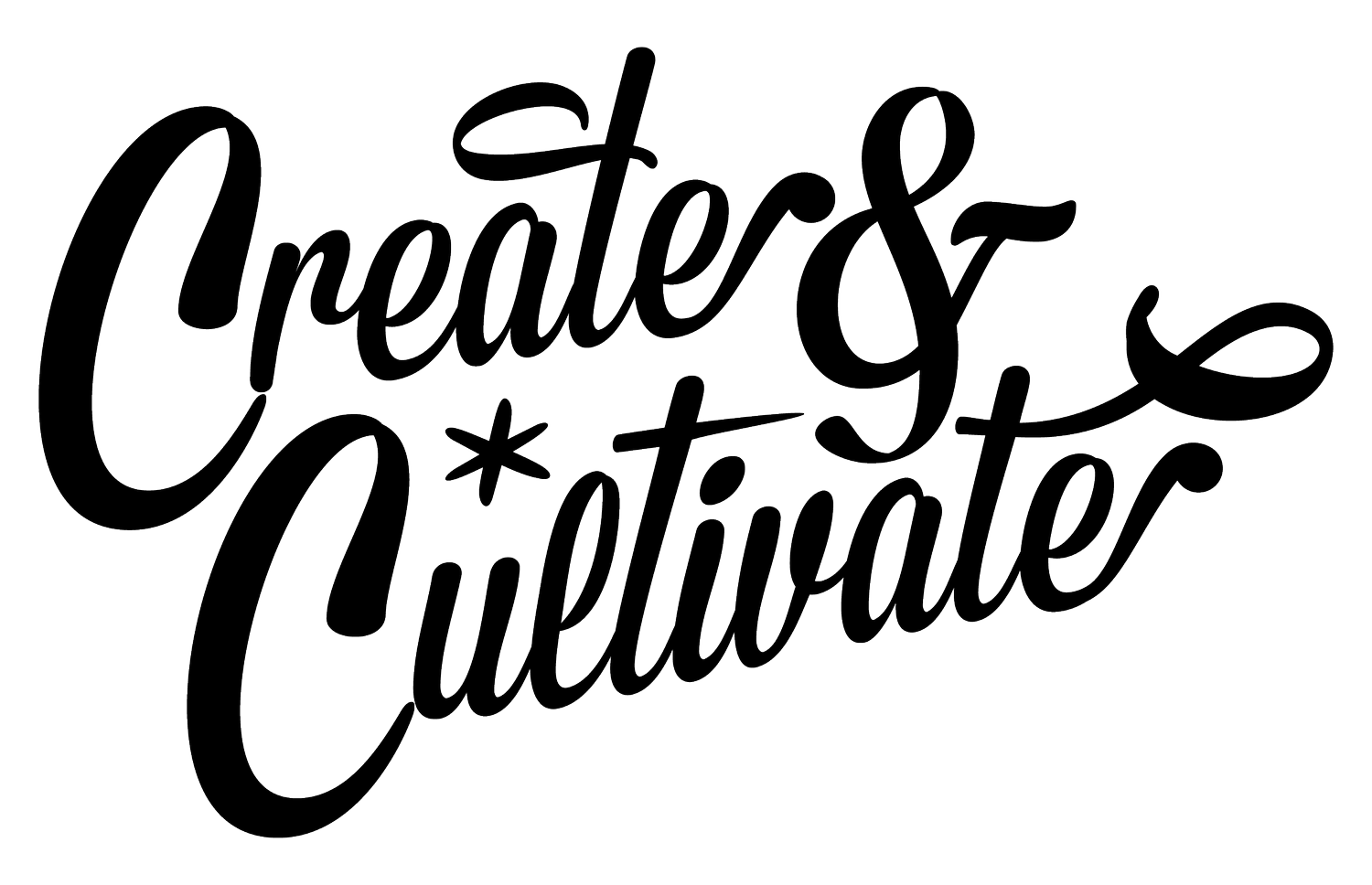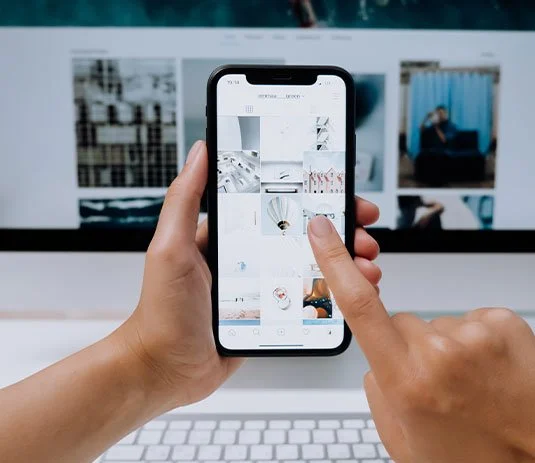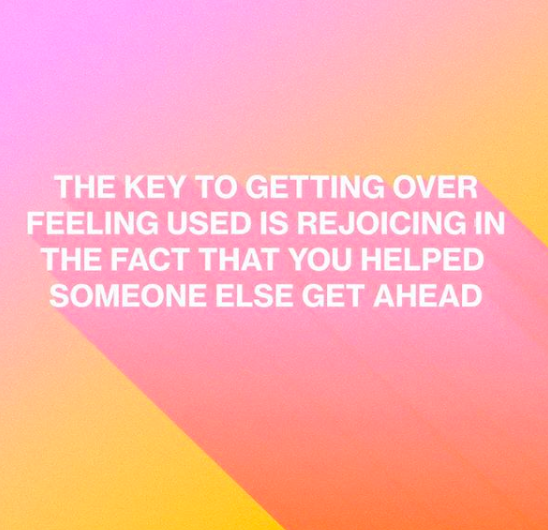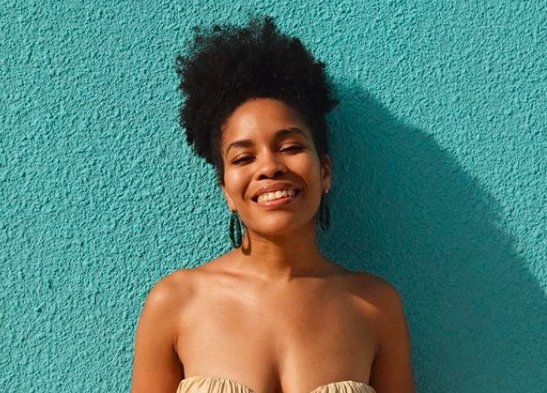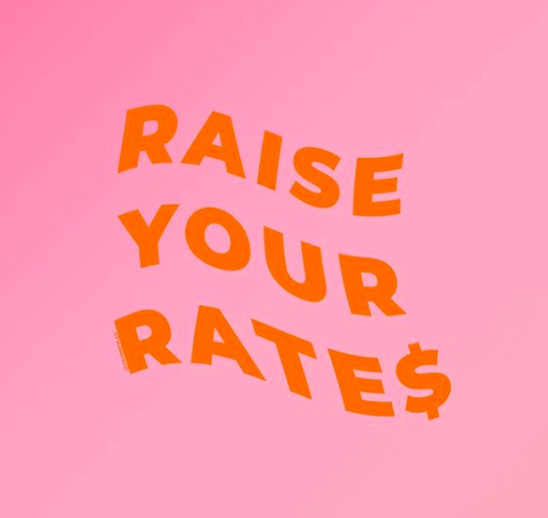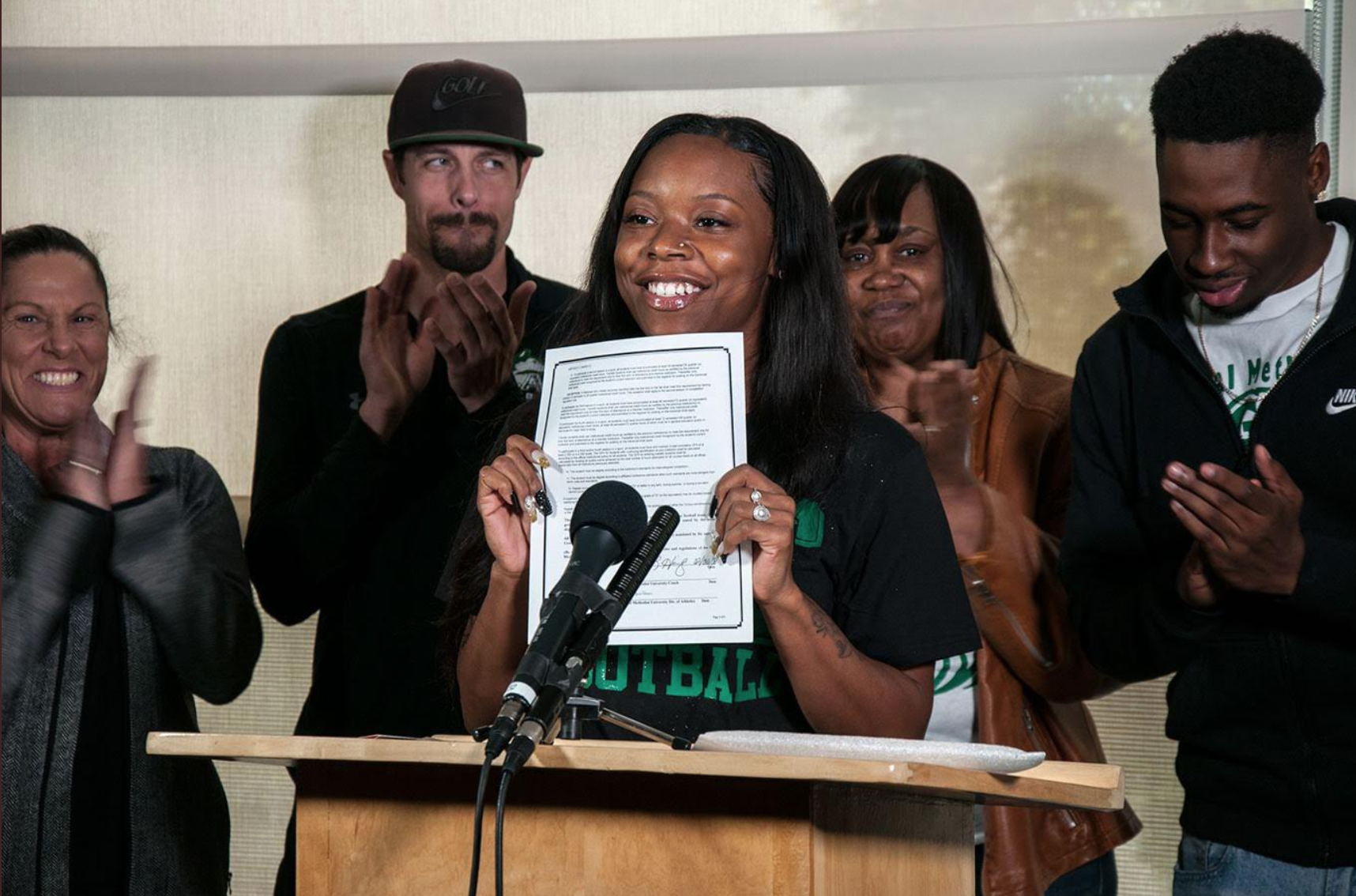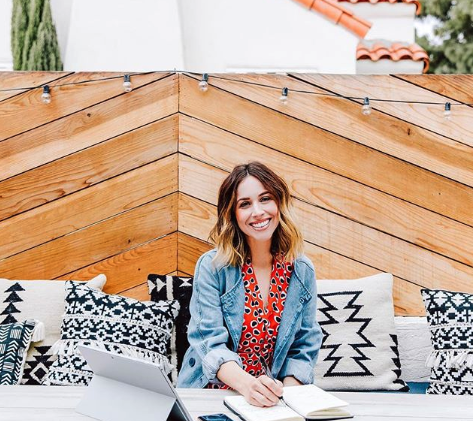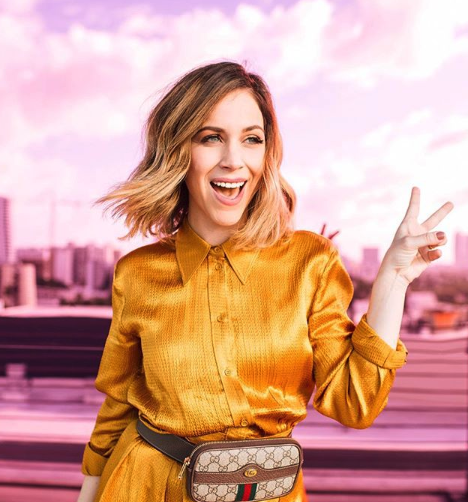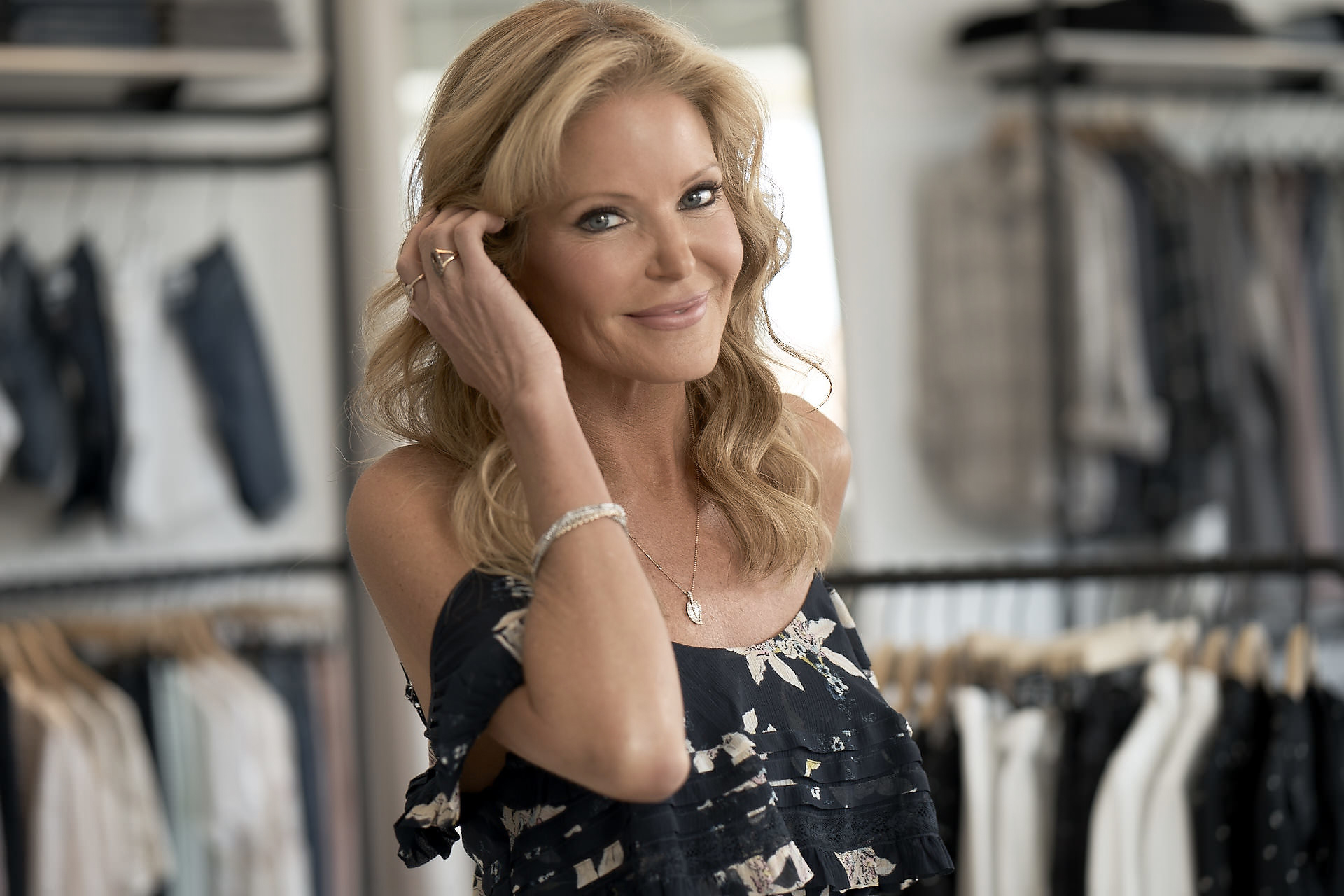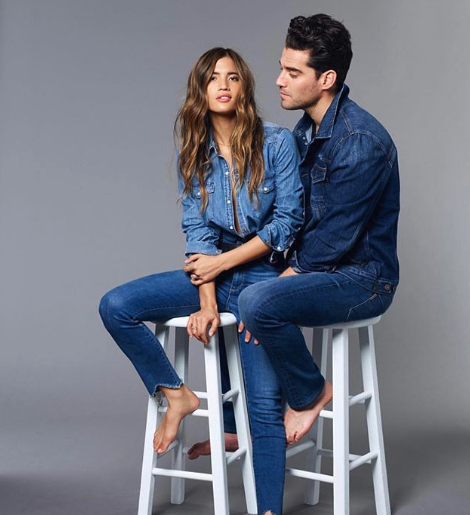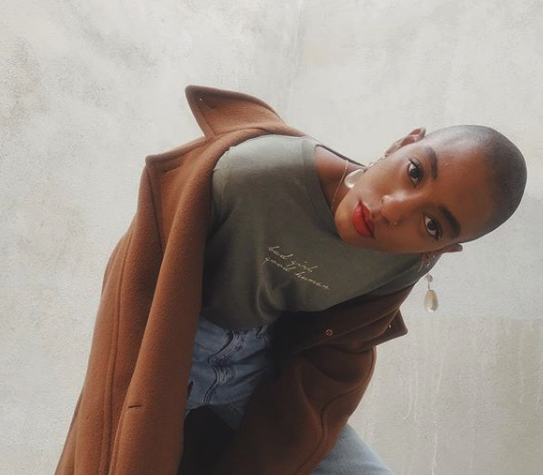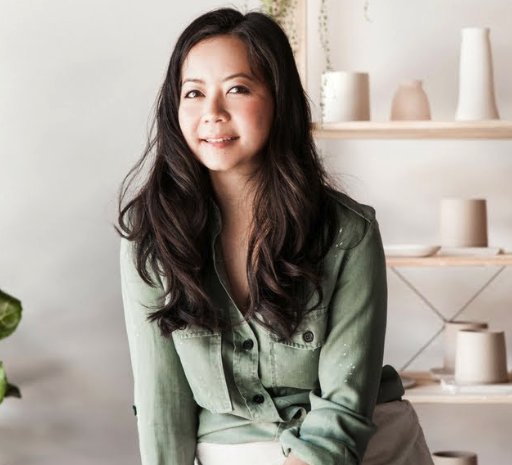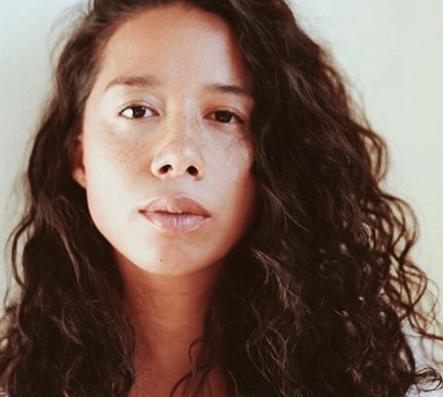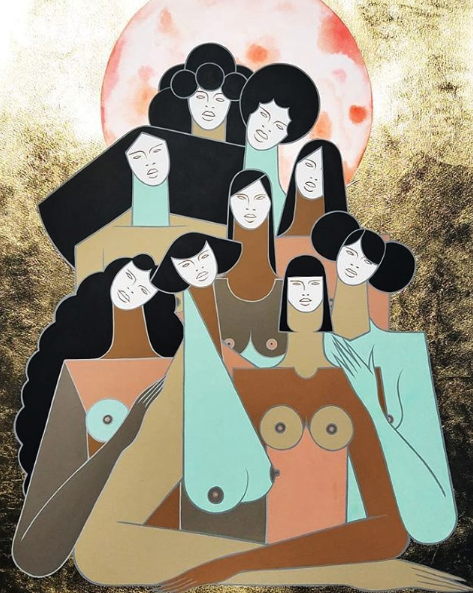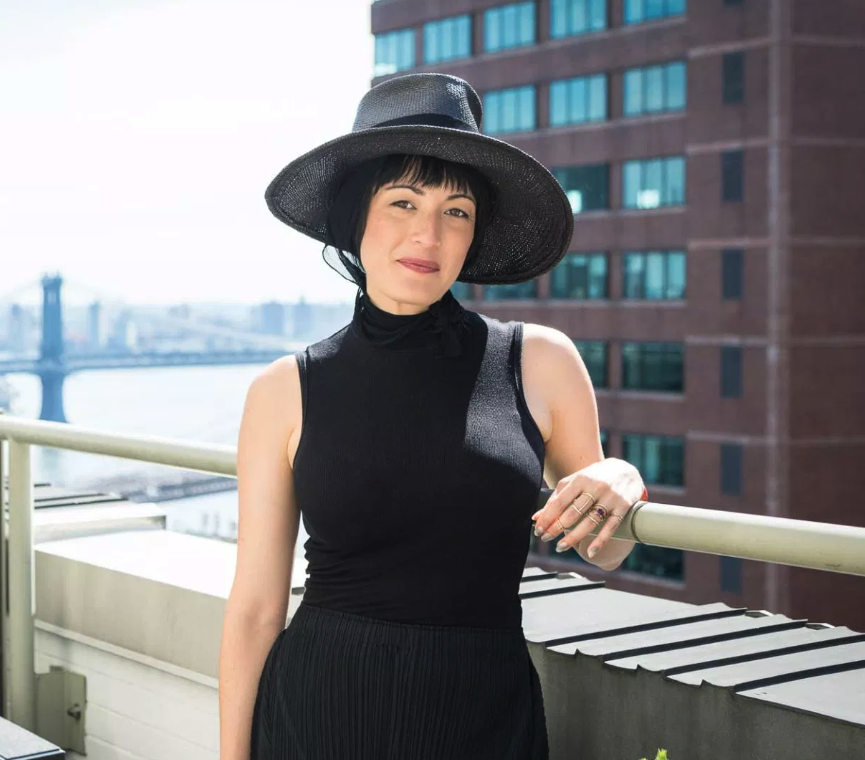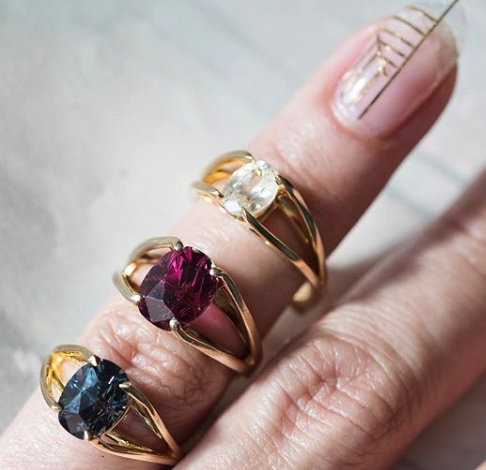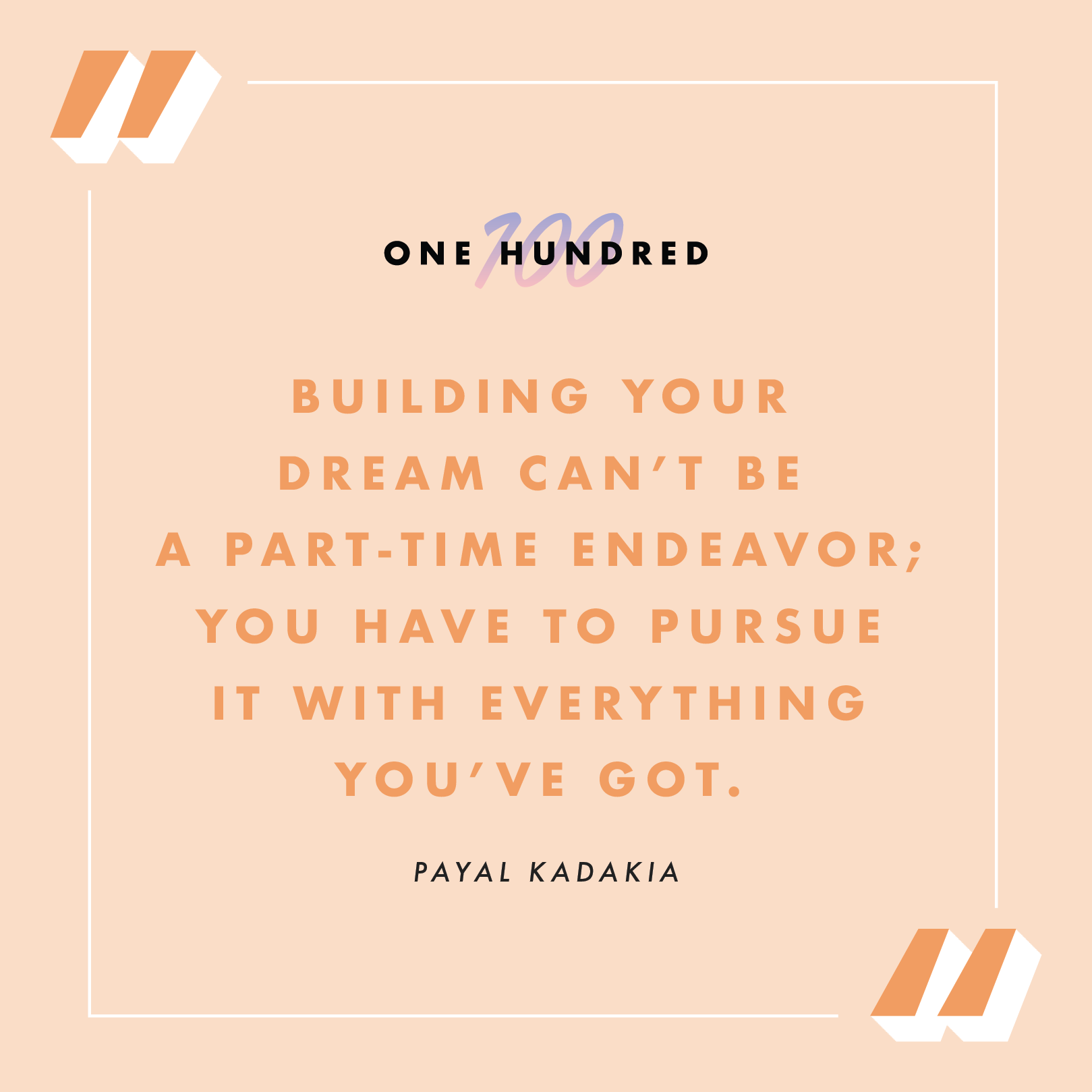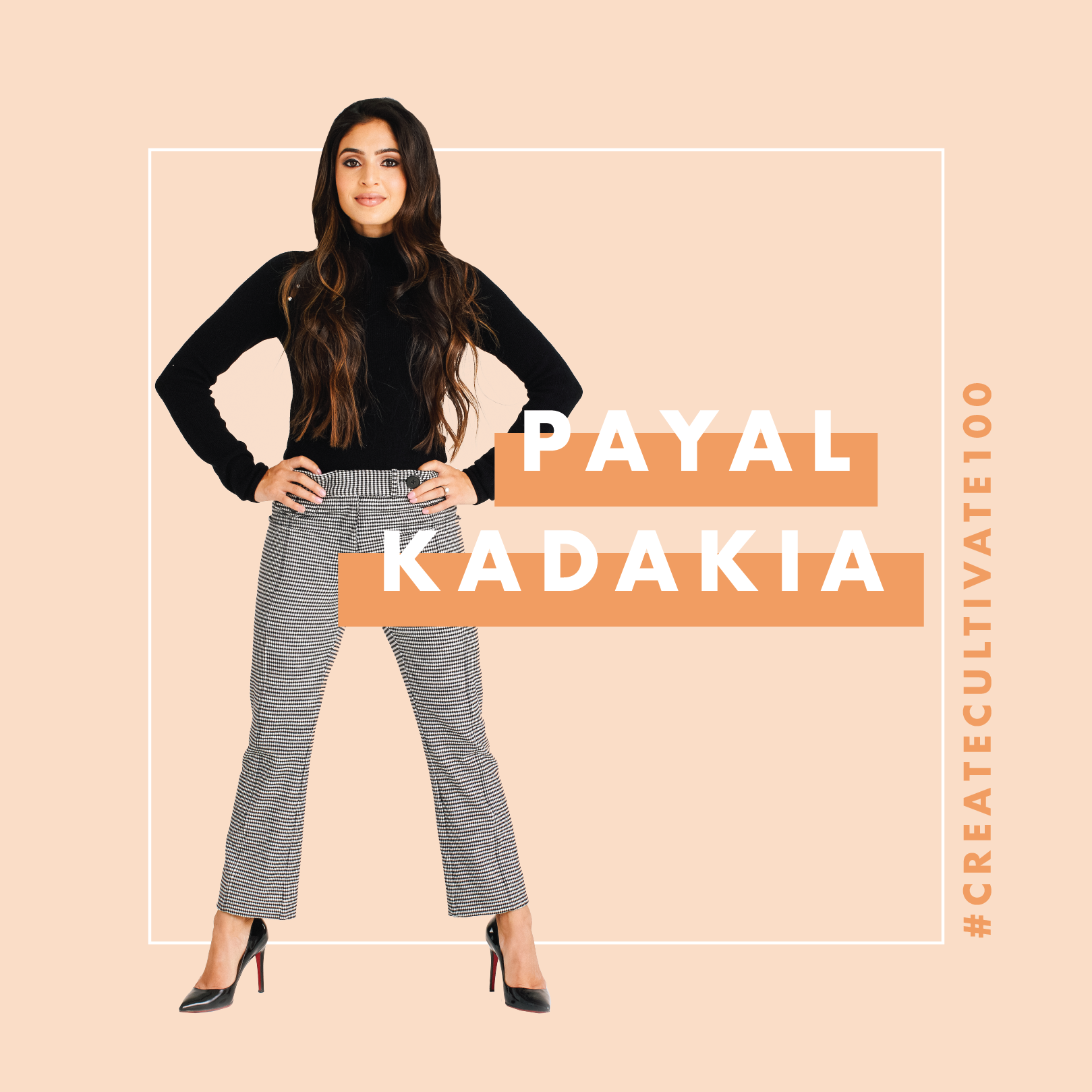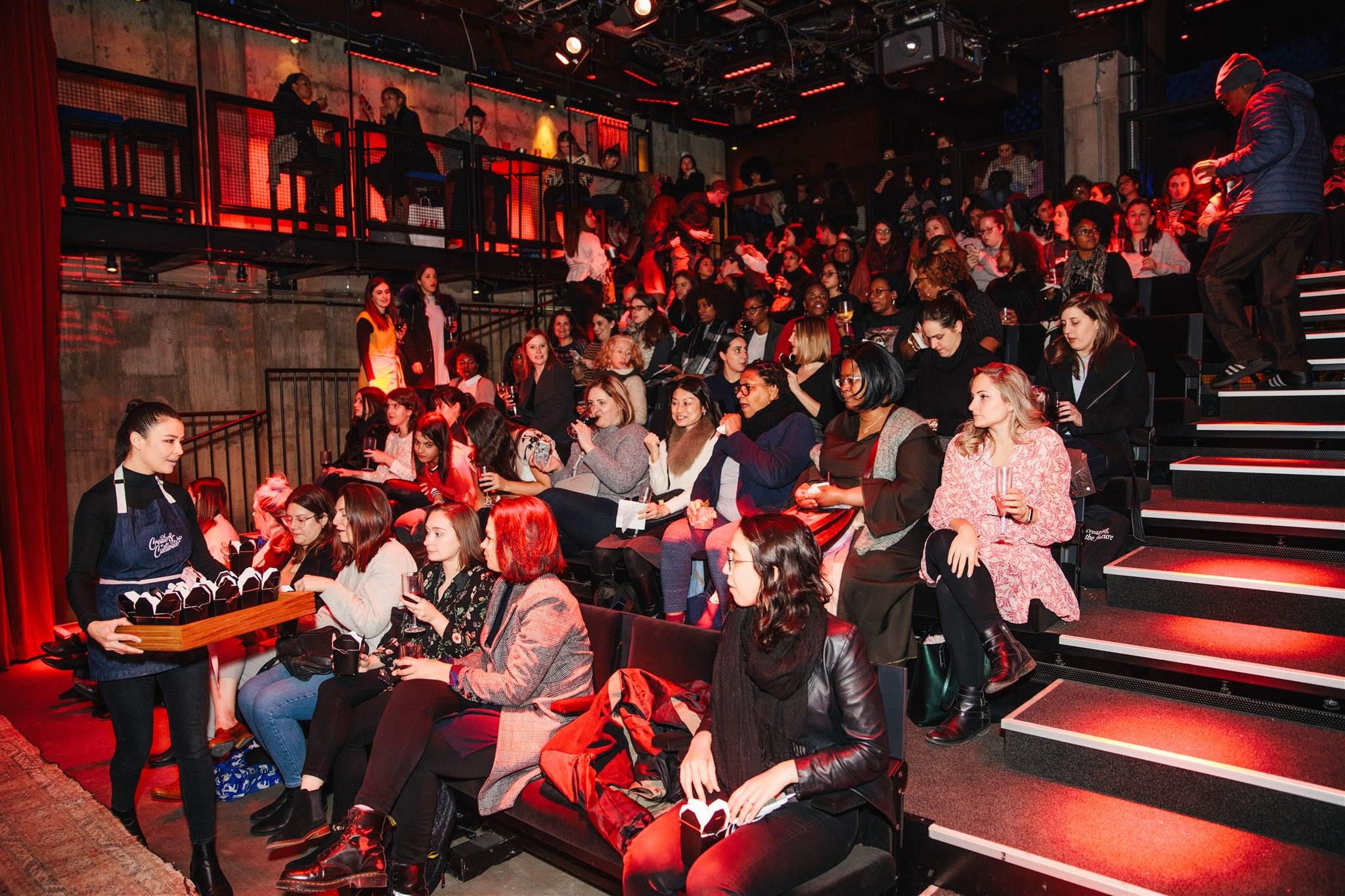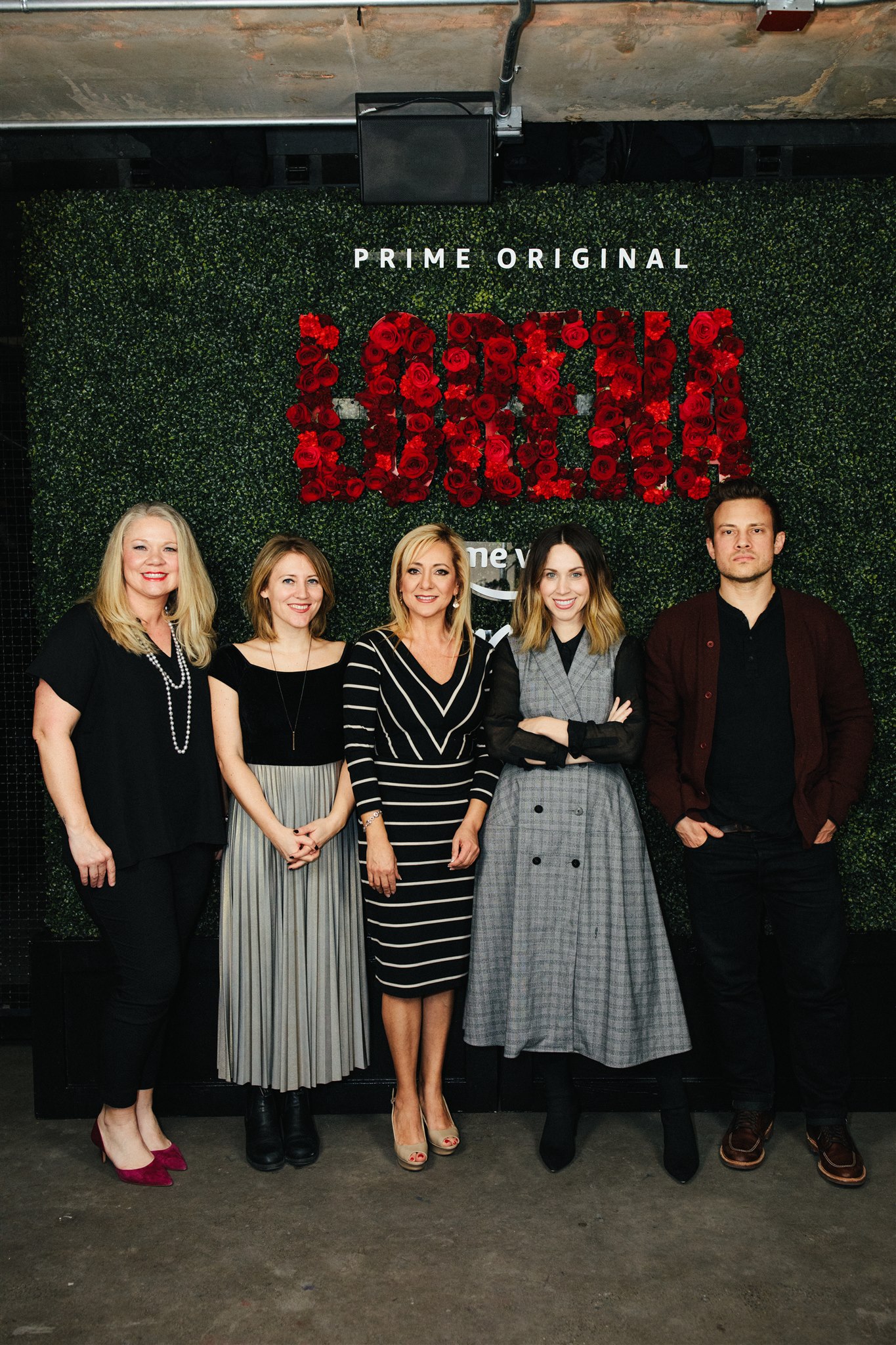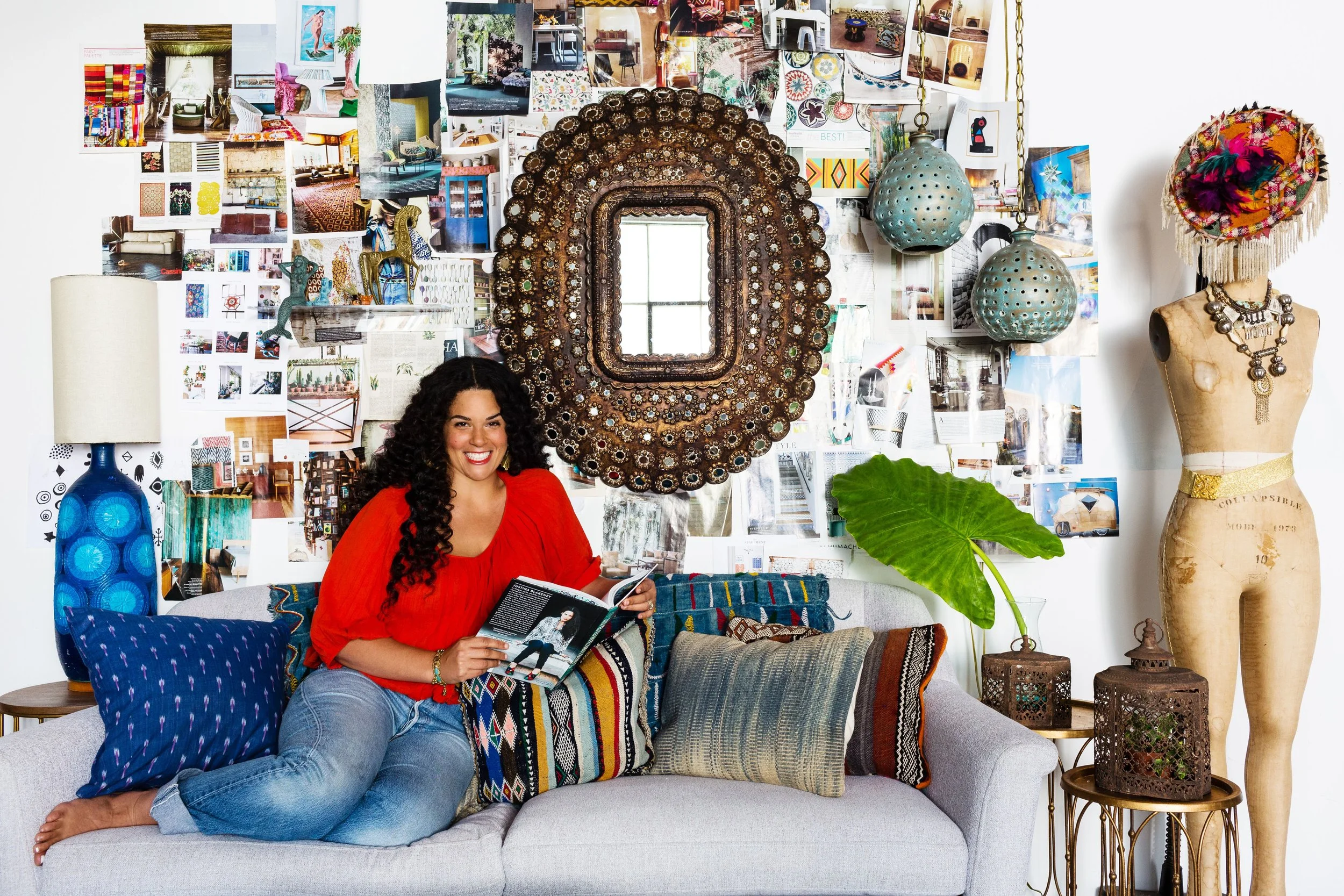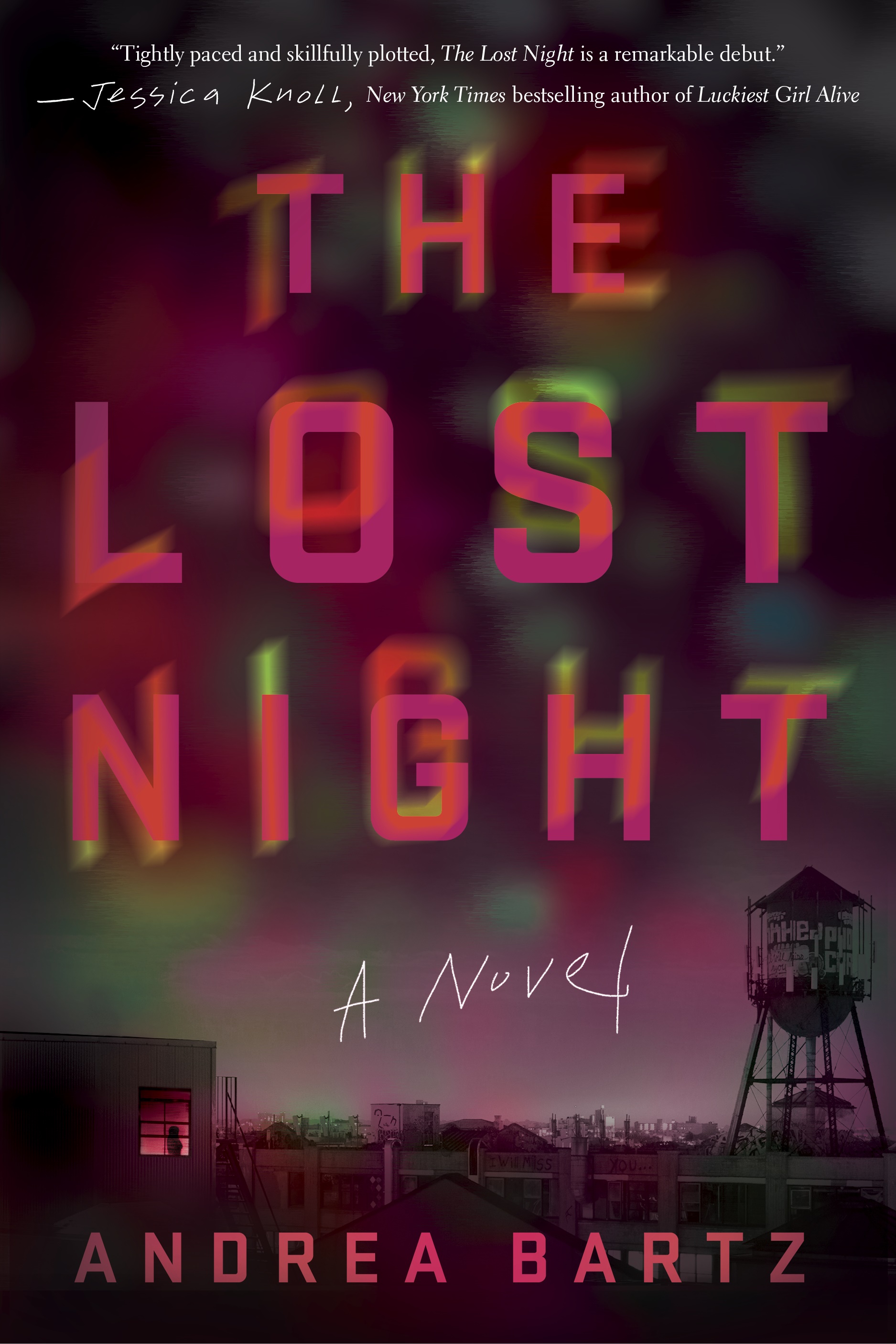How This Marketing Director Rebranded a Company to Target Millennials
“I truly feel empowered in my role to try new things and take risks, and what we do makes an impact on people’s lives every day”
Leslie Albertson lives life in full color. As Mixbook’s marketing director, she’s bringing her personal flare to the design company that helps everyday people create the photo books, calendars, and cards of their dreams.
Read on to hear how Leslie took on the task of rebranding Mixbook to appeal to a younger audience.
Tell us a bit about your journey to marketing director at Mixbook.
I first joined the Mixbook team in 2013 to lead mobile marketing for a new photo book app we launched. I was focused on building the Mosaic brand through partnerships, growing our customer base, and acting spokeswoman at conferences and events. I became the Director of Marketing for Mixbook in 2015, when I was about 6 months pregnant! Quite the time to get a job promotion - but it shows the tremendous culture and support within the Mixbook team. My main focus at that time was developing our marketing communications and content strategy - including email, social, and the blog. As I dove into the Mixbook brand, I realized that we hadn’t done a great job at carving out our place in the market and really tapping into an underserved market of DIYers. This kicked off a very thorough deep dive of our brand intent, identity, and ultimately led to a rebrand. The process took about 18-months, and it’s one of the things I’m most proud of. As of today, I lead Brand and Partnerships, focusing on engaging events, inspirational content, and growing our brand awareness through partnerships including influencers, designers, creators, and like-minded brands.
What about your job makes you feel the most fulfilled?
Being creative and making an impact. I truly feel empowered in my role to try new things and take risks, and what we do makes an impact on people’s lives everyday. A photo book captures some of the most precious moments in time and allows people to create and connect more deeply. That feels really good! And, I love hearing the unique stories of our customers and how they use Mixbook.
How do you breathe new life into a company when you yourself are new to the brand?
Always understanding who your customer is. Understanding your customer forces you to think differently and from their perspective. I think whenever you are looking to refresh a brand, you have to have a deep understanding of why you do what you do, what the core brand values are, and who your target customers are. Simon Sinek has this Golden Circle theory which should be the foundation to any brand. First, answer why you do what you do, then the how you do it, and then the what. Many do this backwards. Also, understanding your customer is key. Having at least 2-3 customer personas deeply defined (and based on data and actual customers) are essential too. Once you get an essence of your DNA, then the magic happens. You explore colors, type, imagery, inspiration, mood boards, and real-world feedback to help bring the visual identity to life. It’s definitely a lengthy process, but with the right approach and data to back you up (and a little faith from your exec team), it all comes together. I had been at Mixbook for over 3 years at the time of the brand deep dive, so for me I think it was more of a challenge to take off the hat of ‘what we have been’ and defining ‘who we wanted to be’ and where that fit into the market. When I look at where our brand is today - our website, logo, photography, social, messaging - it all feels so much more authentic to who we are.
What were the biggest challenges coming into Mixbook? How did you overcome them?
Shifting from marketing social mobile apps which focused on driving installs and monthly active users (MAUs) to an e-commerce company where we ship a physical good was a totally different space for me and forced me to learn a new set of business metrics. I had to learn the ins and outs of pricing, gross margins, bookings, and the cost of a customer. Having great mentors and working with an incredibly smart team helped me a ton. I’m incredibly grateful for this experience - I’ll be ready if I ever get on Shark Tank!
What strategies have you used to appeal to a younger demographic?
Primarily influencers, events, and content that aligns with current trends and what’s popular amongst younger millennials - not just moms and grandmas. Some think Mixbook is just for moms, but almost half of our customers are single, working, globetrotters that like to capture their big beautiful life. Also, I think we’re really in this era of nostalgia (hello ‘90s) where millennials are now ditching social media and material things for experiences and real life connections, which is exactly what we’re all about - capturing those experiences to create deeper connections with those you love.
What are the common challenges you've seen among female executives & directors?
In my personal experience, one challenge that I do see is finding the balance between motherhood and a career. I find that nearly all of my time is given to my career and my child, which gives little time for self-care like exercise, clean eating, and nurturing my own relationships. I think finding the balance is hard for all of us, but being conscious of taking time to care for my needs as well has become more of a priority as I’m getting older and makes me better in my career and at home.
What advice would you give to young women just getting started in marketing?
Try a lot of different things. Work for a startup or try an internship and wear a lot of hats. There are so many facets to marketing - customer acquisition, content development, SEO, email and lifecycle marketing, research and analysis, and more. I’m a big believer in finding something you're passionate about but can also make a career out of so you feel fulfilled in your role.
“I truly feel empowered in my role to try new things and take risks, and what we do makes an impact on people’s lives every day.”
Where did the idea for your pop-ups come from? We loved what you did in Palm Springs!
We wanted to bring our passion for creativity and connection to real life experiences and show the unique ways you can create with Mixbook. We definitely found inspiration from some of the immersive pop-ups over the last year like the Museum of Ice Cream and Color Factory, but we wanted to go a step beyond and give people something they can create and take with them. We’ve done everything from a giant sunset-colored ombre gallery wall, where we had writeable Mixbook acrylic prints. Guests could write an inspirational message and snap a photo. We’ve also done experiences like Mixbook holiday cards used as letters to Santa, where you could pick a card from a colorful envelope wall, decorate it, and drop it in a mailbox destined for the North Pole. We love to encourage people to explore their creativity and connect with others around these experiences. I think these types of experiences make lasting impressions and we want to be a part of that!
We hear you’re launching a big project with Joy Cho (of Oh Joy! fame). Any inside info you can share?
Yes! We are so excited for this collaboration. She’s been a big inspiration to us and we feel lucky to be able to bring her colorful and fun designs to Mixbook. The collection is inspired by travel, color blocking, spring and summer colors, and the signature Oh Joy! elements like confetti and glitter. There are some fun designs to get the kids involved too so families can get creative together! We’ll be having a launch party that brings some of the collection’s elements to life in a pop-up experience at the Southern California Children’s Museum on March 23rd in Pasadena, CA. There will be a TON of activities for the kids, and colorful IG-worthy photo opps for the adults. We’re also collecting craft supplies for Shriners Hospitals for Children to support creative programs for their kids and families in need.
What’s the best piece of advice you’ve ever received?
Life’s a journey, not a destination. This mantra has been incredibly grounding anytime I’m questioning (or freaking out about) what’s happening in my life. It’s important to have goals and direction, but being present and embracing the challenges that come with juggling a career and motherhood is key to overcoming what can seem like the impossible. It’s about trusting in the process and believing you are exactly where you are supposed to be in this moment.
What are you most excited for in 2019?
Continuing to grow both personally and professionally. I’m so proud of where Mixbook is today and so excited to continue to expand our partnership and content to inspire more people to create and break down the ‘I’m not creative’ barriers. Personally, I’m excited to take time for self-care which includes more yoga and slowing down!
MORE ON THE BLOG
Do You Really Need to Be a Full Stack Employee?
Is being a full stack employee more impressive and efficient, or is it a recipe for spreading yourself too thin?
If you really want to land that dream job, you need to be sure that you’re making yourself as marketable as possible to a potential employer. Obviously, if you are more experienced and have a wide variety of skills you already have a leg up on the competition and are one step closer to getting hired. However, is catering to a broader spectrum of tasks in order to impress an employer more efficient, or is it a recipe for spreading yourself too thin?
Being a full stack employee doesn’t mean that you need to be able to do every job there is to do under the sun. By allotting yourself a list of tasks that are catered to the position that you’re looking to get, you’re able to give yourself and your employer/client a better understanding of what you’re able to do rather than promise to do tasks that you might not be able to do to their full capacity.
IS BEING MULTIFACETED MARKETABLE?
There is no doubt you should find the ways to get a leg up on the competition and stand out to your potential employer. If you’re a marketer, and your potential employer hears that you know how to produce content, edit, write RFP’s, know how to manage social, know how to edit a website, and even walk their dog; there’s a pretty good chance that you’ll get the job. However, there’s a difference in being able to cater to your employer/client’s needs and over-promising on things that you won’t be able to fully execute.
We won’t argue that there is a large demand for full-stack employees today, especially in the startup world, but the more your over-promise the more you run the risk of running into situations where your attention is pulled into so many directions your work is suffering and you are not getting tasks completed to their full potential.
THE MORE TASKS YOU HANDLE, THE LESS FOCUSED YOU CAN BE.
Think about it you’re writing and being your own editor, running meetings, taking notes, creating content, shooting photos, creating graphics, handling events, running production and now you're at the point where you’re not even sure what your title is anymore. Are you even a marketing director anymore, or are you more along the lines of a creative director? Or are you something completely different then what you began as? You don’t even know what to label yourself as.
Sure tackling on all these tasks can look impressive on paper, but you might be doing yourself a disservice by having your attention divided on so many different tasks that you less focused on the more important ones. Not only that, but if your employer may start to see that you are not able to fully dedicate yourself to the tasks you promised; they might start to think that you lied on your resume to get the job. If you want to truly make yourself a full-stack employee, you have to start off with prioritizing and focusing on the most important task and then see how you can branch off into the specifics.
NARROW IT DOWN.
Even if you’re a full stack employee, you still need to set your limitations, while understanding that you can still be niche and specific. For example: if you’re an editorial director you can also say that you write content, handle an editorial team, edit content, shoot content, pitch sponsorships, and even edit content for your social media manger. Know yourself, your limits, your capabilities and be confident in them.
At the end of the day, you want to be able to do your job to its full potential and still be able to wear a lot of hats. That’s what will make you truly marketable and will ultimately land you that dream job.
MORE ON THE BLOG
How This Brand Strategist Is Building a Girl Gang for Black Creatives
“That’s what wakes me up in the morning: knowing I’m collaborating with women from all walks of life to design the brand of their dreams.”
Brittany Wilson is a woman you want to know. Formerly in fashion and marketing, she launched her design and branding studio, The Idea Girl, in 2017. Since then she’s been helping budding entrepreneurs and business owners figure out their company mission—and then going out and living it.
Below, Brittany shares the secret to her success.
What inspired you to start The Idea Girl? What need did you want to fill?
Two things actually inspired me, for one my multifaceted background often left it hard for me to find a career I thought I could grow with and hearing my family say things like “Jack of All Trades, master of none” didn’t help much either. I love creating beautiful things to make people feel good about themselves, and I’ve had many vehicles serve that common core. I’ve worked as a sales associate, visual merchandiser, and assistant buyer to passionately shop with strangers for their most intimate moments. I’ve also worked as a marketing manager, office assistant, and even become an operations manager for a Mitsubishi dealership to spice up the skillset. By age 24 I was working a crappy receptionist job and fighting a tough battle with depression. I was tired of getting hired, fired, and climbing up the ladder and losing to office politics.
Sick of being in a slump, I decided to create the life I wanted including a job I’d fall in love with. I realized that I was the go-to person at work and in my circle for all things aesthetic related from fashion to interior design, which created the “aha moment” of calling my brand The Idea Girl. I decided to take all my skills and talents and create a job title that included all of my expertise in one. I want to show women everywhere that we are malleable, fluid, and multidimensional and can manifest our thoughts into action. I want to show them that having a title holds no value and break from it boundless to be the creative forces that we are meant to be.
Two, the lack of economic power and freedom within the Black community is what shifted my focus to working with women of color specifically. Art, creativity, and talents are typically frowned upon in our culture due to the older generations faith in the hospital and government jobs. Many of us are tricked into believing that a college degree will provide us with security and a moderate paying job will be the safety blanket we need. WRONG! I wanted to break that generational curse that’s kept so many young people of color from pursuing their dreams and tapping into their innate and artistic abilities. Through The Idea Girl, we empower women of color into entrepreneurship by helping them dig deep within to monetize off their skills and talents through adept strategy and emotive design approaches so they can shine confidently next to their competitors and communicate with their clients. We needed a space where we can thrive financially, spiritually, and professionally to break generational curses and pass down our wealth. There weren’t too many creative safe havens for women of color, so I created one.
“Decide what makes you feel good and progressive. Stress is real, not-so-easy clients are real, and time is limited—so make it worth your while and feel good all of the time.”
You work solely with woman-owned startups and female entrepreneurs. What drove you to make this business decision?
I love working with women because I am a woman. Women are fighting adversity on a daily basis from their wages to their body rights. Starting my own business lit a fire in me that I never know could be ignited, a feeling so contagious that it was obligatory that I spread it. There is nothing like seeing another woman finally recognizing her worth, reclaiming her time, and fully investing her talents into a business to help solve issues both big and small. Forbes recently said that Black women are the fastest growing entrepreneurs in the nation, it makes me extremely proud knowing that I am one of the people behind the scenes accelerating this spike through my work to help women like me shine.
What’s been the most fulfilling part of your job? What about the biggest challenge?
The most fulfilling part of my job would have to be the look on my client’s faces when I bring their brands to life with design. Seeing is believing, so once they start seeing mockups and prototypes it’s like “Woah, sh*t’s getting real!” and the ideas and inspiration begin pouring in abundance. Their confidence beams through their smiles, and in that moment I know I am fulfilling my purpose. The biggest challenge would definitely be balancing my personal life and prying myself away from my laptop. Sometimes I’m so obsessed with what I do, that I’m afraid to go to sleep in fear of missing out of something. I even have to watch my dialogue when speaking to my boyfriend, friends, and family so it isn’t always work-related. My mind keeps me up, and I’m always overworking. I have to be extremely mindful of my body and the messages it sends me. If my body says she’s had enough, I know it’s time to hit the lights and to hit the sack. My biggest challenge staying healthy (mentally), keeping my body going, staying hydrated, and keeping anxiety at bay.
In the FAQ section of your website, you post your studio hours. This isn’t a common practice among entrepreneurs. Why do you think it’s important to let clients know your availability?
A friend of mine was actually the one who encouraged me to enforce office hours to set professional boundaries between my clients and I. There would be times where I would receive emails at 3AM and felt anxious and reluctant to answer every request at any given moment. It was wearing me down, so for the sake of my mental and physical health, I keep my office hours up to let my clients know the times they can catch me working and when they can get a response. Communicating that in the most professional way possible is also key. I let my clients know that I have every intention of completing their requests and I politely reiterate my policies and all possible options we can take to move forward. It’s important to inform clients and prospects the times they can reach me, but it’s just as imperative to let them know when I’ve clocked out for the day. I also have specific days set where I take phone calls that way I won’t lose track of time and can focus on my design projects for most of the week as that can also cause major distractions. Having a work schedule actually helps me leave work at work, so I can enjoy life outside of it; money isn’t the key to happiness but peace of mind most certainly is!
Time management definitely taught me the importance of managing effective office hours. You have to time everything you do and decide what makes you feel good and progressive opposed to funky and regressive. Stress is real, not-so-easy clients are real, and time is limited so make it worth your while and feel good all of the time. I set my boundaries with time and let people know to respect it in the sweetest and most professional way possible. Also, it kind of gives me a reason to light a spark my clients. It’s like being a coach or teacher, teaching them the importance of slaying their business goals in between there 9-5pm. Plus what I normally do, my clients follow suit to improve their lives. When I make better use of my time, so do they, and I love impacting them in that way.
You host GRLPWR Launches to help business owners hone their brand strategy and marketing solutions. Tell us a bit about what that process entails.
The GRLPWR is a combination of brand strategy, marketing, and creative solutions individually crafted for each brand I work with. Typically for business newbies or seasoned girl-bosses who want to implement a new endeavor, I work side-by-side with women to help get their ideas out of their heads and into their pockets by building out content plans, connecting them with ladies in my professional network who can help them execute their vision, and exploring future opportunities by mapping out their objectives and aligning them chronologically according to what makes the most sense right now in this moment. I give my clients the freedom to think out loud and devising a plan to get there from A to Z, figuring out where to monetize and what part of their business to invest in first. We start off with deep brainstorming where we formulate ideas and concepts with action plans to get started. Then they go through a series of workbooks to develop their brand and communications strategy before we develop a customized vision board before executing the launch.
“The Idea Girl Gang celebrates Black creative women by sharing a safe haven for them to network, find jobs, learn skills and join a sisterhood of ‘sistas’ ready to cheer them.”
You created the Idea Girl Gang to help black women in business find work and skill swap. How is the IGG different from other women’s career groups?
In the Black community there are sorority and fraternity organizations but very few that target Black women that are taking the road less traveled in not-so-ordinary fields. The Idea Girl Gang celebrates Black creative women by sharing a safe haven for them to network, find jobs, learn skills and join a sisterhood of “sistas” ready to cheer them. IGG welcomes all female-identifying creatives of all colors, classes, and creed. Although we primarily focus on providing professional resources for Black women, we welcome our community to all people who aspire to uplift and elevate women of color.
What do you think are some challenges that face female business owners and entrepreneurs today?
I think one of the main challenges is not being taken seriously or seen as a “boss” like our male counterparts. By stereotypical measures of gender roles, women are assumed to be incapable of making tough decisions or can’t be taken seriously if our clothes are too tight. Women are badass and we get the job done with no questions asked. We wear many hats and take on jobs as counselors, strategizers, designers, and planners. Sometimes I find myself adding a bit of bass in my voice when getting a point across or during a negotiation to show people I’m not here to play and that I am just as deserving to have a seat at the table. As a woman, it’s important to have an organization that promotes love for other women and sisterhood so we can be there for each other and break glass ceilings together.
“That’s what wakes me up in the morning: knowing I’m collaborating with women from all walks of life to design the brand of their dreams.”
Who are some female designers and entrepreneurs (maybe even some of your clients!) who inspire you? Why?
Lotta Nieminen is definitely the Queen of Design in my book. Her style is so minimalistic, clean, and abstract. Jade Purple Brown is also one of my favorite illustrators with her use of bold splashes of color and homage to women of color. Most importantly, all of my clients inspire me as they are the true Idea Girls. They come up with the most innovative and creative inventions with great intent. Not only are they slaying the day at their 9-5’s they’re rushing home to speak with me to build an entire empire. That is what wakes me up in the morning, knowing that I am collaborating with women from all walks of life to design the brand of their dreams.
What are you most looking forward to in 2019?
For 2019 I am most looking forward to the unknown, and just living life spontaneously. This year has started off amazing for me thus far with my first speaking engagement, two successful events, and traveling to meet my IG girlfriends in real life! I’ve been opening myself up to receive more love and I’ve been walking blissfully blind, hand in hand with faith. I trust myself a lot more, and I trust whatever the Universe has in store for me. Opportunities and doors are opening everywhere so I am ready for whatever 2019 has to bring. More life, more love, and more vacations!
MORE ON THE BLOG
Making Moves: Female Football Players, Women Astronauts, & Brand New Barbies
Great news for girls everywhere!
The first full week of International Women’s Month has not disappointed! Celebrate International Women’s Day with us and read on to learn how women are crushing it this week in football, film, and outer space.
College student Toni Harris became the first woman to sign a letter of intent to attend a university on a full football scholarship. The 22-year-old defensive back dreams of becoming the first woman to play in the NFL and proving that it’s great to play like a girl.
One giant step for womankind: NASA astronauts Anne McClain and Christina Koch will be participating in the first ever all-female spacewalk. They’re scheduled to head out to space on March 29th, a great way to celebrate the end of International Women’s Month!
Where are all the women? New York City announced that it will add four statues of influential women in an attempt to combat the gender gap present in public art. The women to be memorialized include jazz singer Billie Holiday and pediatrician and activist Dr. Helen Rodríguez Trías.
Girl power for generations to come! Mattel is releasing a Barbie doll of activist, model, and Gurls Talk founder Adwoah Aboah. The doll will be part of Mattel’s “Shero” program, which highlights influential women like Ibtihaj Muhammad and Laurie Hernandez.
IMBDPro and the ReFrame coalition of industry leaders released a list of 20 films from 2018’s top 100 box office movies that are certified as gender-balanced productions. The list includes Crazy Rich Asians, The Hate U Give, and The Favourite. ReFrame hopes its data will celebrate and promote the films in Hollywood that have just as many women working on them as men.
MORE ON THE BLOG
C&C's Founder Shares Her Tips for Scoring & Succeeding at a New Job
“If you learn your boss’ love language, you'll be in a really good place.”
If you’re a regular Create & Cultivate reader (or maybe even a member!), you need no introduction to our founder, Jaclyn Johnson. The Forbes 30 Under 30 honoree started her own company at 23, then sold it in 2016. Now, at the helm of C&C, she’s helping women around the world create and cultivate the career of their dreams. And that’s exactly why she’s a member of our new Mastercard Women’s Business Advisory Council. Throughout the year, members of the council will be popping up at events and online with advice on how to get your small business off the ground—stay tuned to learn more!
Jaclyn shared with Teen Vogue the story behind C&C, the challenges she’s faced, and the best way to get on your boss’ good side—read an excerpt of the interview below.
TV: You started Create & Cultivate when you were still pretty young, and it became so successful in a relatively short amount of time. Some people might look at your journey and think you made it look easy. But in reality, what challenges did you face?
JJ: Well, it wasn't a short amount of time. That's something that everyone always thinks. But the first [Create & Cultivate conference] was in 2011, so it's actually been going on for over seven years. In terms of the growth, it's obviously grown a lot. But there's so much hard work and intensity behind it. For a while, I was running both companies: I had my old company, [marketing agency, No Subject] and Create & Cultivate at the same time. I was working 150-hour weeks balancing both teams, running both financials — it was so much and so intense. I mean, it's great it looks easy, but it definitely hasn't been that way.
TV: What about before Create & Cultivate — what were some of the biggest challenges you faced in the earlier years of your career?
JJ: [With] my first company, there were so many different challenges. Number one is trying to be the boss when you yourself don't have that much work experience — trying to navigate those waters and learn. At the the beginning, I took a lot of things personally and really didn't manage myself well because I was so invested in everything [and] I was so young and not equipped to handle things.
TV: How did you overcome those challenges?
JJ: Experience. You get better over time; it gets easier over time. You'll be a better problem-solver. You just have to go for it, make mistakes, and learn along the way.
TV: Did you ever have moments early in your career or when starting Create & Cultivate when people didn't take you seriously because you were young or because you’re a woman?
JJ: Oh yeah, all the time. Even [with] the AV guy today: I [asked], "Can we lower the music?" He said, "Who's asking?" And I said, "The person paying you." It happens all the time. People think I'm really young. [...] At happened at the beginning of my career all the time. It's one of those things where you just have to have the confidence and the presence of mind to put people in their place, move on, and keep focusing on your own stuff. Head down, focus on the work, and then you no longer have to prove yourself because you know deep down that you deserve to be where you are.
TV: It seems some people feel like when they’re in college, they already have to know their career path. What do you have to say to that?
JJ: In college I had no idea how many jobs there were out there. I think it's like, a lot of people are like, "Oh, I can be a doctor, a lawyer." Like you can be all ... You can be marketing, you can be in whatever. Now, it's so different because you can be a content creator, you can have four gig jobs that add up to your full time payment. You can kind of create your own career, and it no longer has to be the fact that you're going to be in a company for 15 years. You can start a company, you can be an independent contractor, you can be an influencer. So I think that now, there's so many paths, so I think [college is] really just about now college giving you the tools that you need to go into the world and know what you want to do.
TV: When someone is applying for their first job, what are some of the biggest dos and don'ts they should remember?
JJ: I think the biggest thing is a lot of people, when they go in for interviews, are thinking that they're the only one being interviewed. But the reality is you should also be asking questions in the interview as well and seeing if it's a mutually good fit for you. A lot of people come in and they're just answering all my questions, [and when I ask], "Oh, do you have any questions?”, [they say], "No." But there should be so many questions [you ask, like], “What's the culture here? What are the hours here? Do I have to travel? What's your goal for me?” The best interviews I've had are [with] women who also ask questions, so I think that's something to take note of.
“The reality is you should also be asking questions in the interview and seeing if it’s a mutually good fit for you. ”
TV: Can people negotiate in their first job out of college?
JJ: Oh, yeah, definitely. I mean, I think you have to go into it knowing what you need to live and save. What is that final number? And then try to get to that number. And then if you don't [get that] immediately, ask for a reevaluation in three months. Always ask for reevaluation in three months, because if you're crushing it in three months and they don't want to lose you, they're going to bump you up to what you want to be at.
TV: What are some of the biggest things you look for when you're hiring?
JJ: Team players. People who come in and would never say, "That's not my job." We want someone who can wear all the hats, be all hands, jump in, do things that are outside of the box, think creatively, [and] come to the table with ideas. Anyone who doesn't want to just be like, "I'm marketing, so I do marketing." [I look for] anyone who's like, "Hey, I'm going to jump in and take out that trash because it's full at the event." Or, "I'm going to jump in and go to this meeting for you because I know you're busy." Anyone who's down to do that — especially in a small company, it's vital.
TV: Aside from negotiation, once you're in your first job, what are the biggest dos and don'ts?
JJ: Number one is learn your boss’s communication love language. Are they a list person? Are they an email person? Are they a pick up the phone person? How do they communicate, and what kind of style do they like? Learn that and do that, because you want to be making your boss happy. If you learn their love language, you'll be in a really good place. I think that's number one.
Number two is working with your teammates to build rapport, because those are the people that are going to build you up and hold you accountable. Especially if you're going into a team that's been established for a while, what are the ins and outs of that team? What is everyone's function? How does everyone work together? [Learn] the rhythm of that group balance.
TV: What advice do you have for people who want to start something or have an idea but think they’re too green or too young?
JJ: No one's too green anymore. If you have an idea, if you're solving a problem, if you're excited about that, then go for it. [...] Big risk, big reward. But also, be strategic in the way you're approaching things.
TV: If you could go back and tell your college self one thing, what would it be?
JJ: I would say that you shouldn't be so hard on yourself. I think there's ebbs and flows. I went through so many crazy things in my twenties [that] I thought were the end of the world. And everything was fine. Everything happens for a reason, and enjoy the journey, enjoy the failures, enjoy the successes, enjoy the heartbreak, the enjoy the love that you get. Enjoy all those things. That's what makes you you.
MORE ON THE BLOG
How The Founder of Media Giant Blavity Hustles Smart
“Fail fast, because the greatest lessons are born out of failures and mistakes.”
Morgan DeBaun is no stranger to brand building. In 2014, she left her full-time job at Intuit to launch Blavity, a media company for black millennials, and has since acquired Shadow and Act and Travel Noire—on top of launching 21Ninety, a lifestyle brand for women of color, AfroTech, a conference and site for black entrepreneurs, and M.Roze, a skincare line. So yeah—she’s kind of a total boss.
That’s why we’re thrilled to have Morgan joining our Mastercard Women’s Business Advisory Council. Throughout the year, members of the council will be popping up at events and online with advice on how to get your small business off the ground—stay tuned to learn more!
Below, Morgan shares why she launched Blavity, how she hustles smart, and the best piece of advice she’s ever received.
What are the common challenges you've seen among female business owners and entrepreneurs?
Being able to get into the room. There are still a lot of closed doors when it comes to women entrepreneurs, whether it be to pitch, or securing funding, it’s still very much a boys club. Hopefully, that will change in the near future with the number of women business owners and entrepreneurs consistently growing.
What was the turning point that convinced you, “It's time to take matters into my own hands? The world needs Blavity.”
It was after the death of Mike Brown. Almost every media source painted this kid out to be a monster, all while his body still laid in the middle of the street. Too often we see the narrative around people of color go from bad to worse in the media before real facts have been presented. Blavity was created to change that.
When you run into a career obstacle, how do you find new roads?
I find new roads by going back to the drawing board and revisiting the original vision. That usually helps me get back to aligning myself with my goals. In doing so, I almost always come across new avenues and alternative ways to get to the job done.
What is your biggest pet peeve?
People who talk a lot about what they want to do instead of just doing it. Actions speak louder than words and execution is everything.
What does the concept of #hustlesmart mean to you?
To hustle smart means to put in the work needed, but doing so efficiently and effectively, so that time, energy and resources aren’t wasted along the way. Sometimes I think people take pride in being “busy” and “working hard.” If you can accomplish the same outcome with less work isn’t that a better outcome?
"Actions speak louder than words and execution is everything."
How has your relationship to that concept changed over the last five years?
I have a team now. We still hold the concept in high regards, but with more brain power, it has become easier, in a way. We work together and are able to pick up on each other’s blind spots, so that makes the process of executing ideas a lot smoother than being alone in my one-bedroom apartment trying to do everything on my own.
What are your biggest fears about running a business?
If I had to take a stab at it, I would say that taking too long to recognize that a project or idea or system just doesn’t work. I love the quote “fail fast” because the greatest lessons are born out of failures and mistakes.
Fail fast, because the greatest lessons are born out of failures and mistakes.
What about your career makes you feel the most complete?
I feel most complete being able to employ people who are underdogs and deserve to work in a space where they can be their full creative selves.
If you had to trade jobs with anyone else in the world, who would it be and why?
I wouldn't. I’m proud, and very much still in awe of what my team has done in the short years that Blavity has existed. I wouldn’t want to be anywhere else.
At what point in your career did you find the confidence to really take charge and become the woman you are today?
It was when I decided to quit my job at Intuit and pursue Blavity full time. It was all sorts of scary and nerve-wracking but I never looked back. I think that when you find something that you’re really passionate about that you’d be willing to do for free then it makes everything that comes after less scary.
What's the best advice you've ever been given? Or your favorite piece of #realtalk?
Stop asking for permission and just do it.
What song do you sing in the shower when you’ve had a bad day?
Beyoncé - "Formation"
Photo Credit: @davisfactor and Morgan’s Instagram
Hair & Makeup: @SmashboxCosmetics @TheGlamApp @TheOuai
MORE ON THE BLOG
FYI: How to Kill it at Kickstarter
Kick start your Kickstarter.
Thompson Street Studio by Robin Stein
In 2014, I funded the launch of my magazine, Knit Wit, via Kickstarter (it actually went almost $10k over my goal). I’m happy to share with you a few ideas and revelations I have had about how to do it—and successfully.
There are plenty of ways to fund a project or business, right? You can dig into your wallet or credit rating, look for an investor (or several), build the business slowly and organically over time, or you can, like I did, turn to crowdfunding. I happen to like the last two ways best, especially if your product, service or whathaveyou doesn’t require a ton of up-front capital in its essence (like a startup, restaurant, real estate, etc.). Both strategies allow for the market to immediately prop up and drive your success. Plus, you won’t be beholden to anyone (which rules!).
But, what can be stressful about turning to the masses is that your 1.0, your Beta, needs to be pretty spotless. You need to be ready for Prime Time at 8 in the morning. You have, in the eternal words of Eminem, one shot (one opportunity). A lot of Kickstarting a project successfully relies on your ability to leverage your network—and believe me, these people don’t want to hear from you twice. Make sure this is The One and then hustle to make it happen. Below are some of the ways I made sure my project was successfully Kickstarted. There are a number of different crowdsourcing options out there. I chose Kickstarter because its a household name, which means I could safely assume everyone I know (and everyone they know) already understands what it is. Also: I’m just really into how high stakes it is. But that’s a personality thing.
Shearling round-up by Tony Accosta
1. Start early.
I started Kickstarting Knit Wit a year before the campaign launched. Not literally, but going out and finding our audience on social was crucial. I invited followers behind the scenes and created excitement around the magazine well before I had even figured out how much money we would need. I started our social accounts October 2013, our campaign ended September 2014, and when we finally did hit “go” on our campaign, our early adopters were already waiting for us. (And excited to spread the word, as well.)
2. Broadcast your process.
If you’re doing high quality work and it’s gaining momentum, people will want to be a part of that. Talented people start appearing, looking to join in. Friends make crazy-helpful introductions. For example, a friend knew two people who work at Kickstarter and got me in touch. They answered lots of my questions and gave some valuable advice (see #3, below). Plus, when we finally launched, they were well aware of our campaign, saw it doing well, and ended up featuring it on the site.
3. Do exhaustive comps… And then take it a step further.
Make sure you really understand what has worked well for similar projects—and then figure out how you can improve. Originally, we weren’t going to do a video. Cherry Bombe didn’t do one and besides, I figured, aren’t Kickstarter videos pretty boring and not super shareable anyway? Our friendly Kickstarter contacts had some convincing stats about videos and funded projects, and urged me to do whatever I could to give my project the best chance of success (remember: one opportunity, right?). I ended up pushing our launch date and putting together a video that felt more true to the projects, like an advertising spot (with heavy influence from late ‘90s Nickelodeon, doi).
4. Check out Kickstarter’s resources.
Kickstarter’s Handbook is extremely helpful and is a great primer to figuring out how the whole thing works. It even tells you some successful strategies to try. And those two helpful Kickstarter employees I spoke to? Little known fact, but every section has a “community manager” and they are available to answer your questions. No insider friend-intro actually needed.
Ambika Conroy by Daeja Fallas
5. Really know your money.
This is the most important one. Making sure that you’ll have enough money to fund your project and fulfill your supporter gifts is one thing (don’t forget shipping!). But if you really, truly only want to do this once, you’ve also got to figure out how much you’ll need to sustain your project moving forward. If you’re having trouble crunching the numbers, I deeply recommended finding a friend, colleague, advisor, someone to help you sort it out. (But remember, don’t ask for too much! People can be turned off by if they perceive the amount as extravagant.)
6. Leverage your network.
If you followed my advice in #1, by the time you launch your campaign, you’ll already have a devoted pack of followers ready to campion you. That’s a great first step. Next is your personal contacts. Divide them into groups (the smaller the subset, the more you’ll keep their attention) and make your pitch via email. Here’s the golden rule of leveraging your personal network: Don’t ask for their money. Not only does it make everybody feel weird, but it’s not what you want. What you want is for them to help you find and broaden your audience, so ask your friends, family and colleagues to share your project on their social accounts (or via email or via carrier pigeon, whatever). It’s free for them, they’ll be happy to do it (see #2) and it won’t be weird. Don’t be weird.
7. Get great press.
To reach lots of people really quickly, you’ll need some targeted and strong press. Make a list of every site that’s relevant to your project and find out if you share any mutual friends with editors, writers, etc. You probably do. Don’t include those people in the mega-ask above. Instead, see if they’re comfortable with an introduction and make sure you thank your friend with a free whatever-your-making later (cost depending, of course).
8. Don’t forget where you came from.
Once your project is funded, you’ll be overflowing with gratitude and warm-fuzzies. Don’t lose that feeling. Completed Kickstarter campaign pages have been recently redesigned to look like blogs because your supporters want—they deserve—some special treatment. Write them updates on your project, exclusive behind the scenes, even some discounts. Your supporters are your people—they turned out when you needed them and they helped you get your project (remember, The One) off the ground.
All images from Knit Wit issue 3, available this month.
Zinzi Edmundson is a Los Angeles-based insufferable multihypenate. In 2014 she co-founded Knit Wit magazine. She is a freelance writer and creative consultant; she is also in a band called Kisses.
MORE ON THE BLOG
C&C Classifieds: twelveNYC, BOXFOX, Create & Cultivate, & More!
Stress no more, your job search will soon be over.
Stress no more, your job search will soon be over.
twelveNYC - Brooklyn, NY
Create & Cultivate - Los Angeles, CA
Participant Media - Los Angeles, CA
Too Faced Cosmetics - Irvine, CA
Modcloth - Los Angeles, CA
ROSEWOOD Creative - Los Angeles, CA
Ayzenberg - Los Angeles, CA
Natural History Museum of Los Angeles County - Los Angeles, CA
Wolf & Badger - New York, NY
Pinterest - San Francisco, CA
Popular Motivational Quotes, Rewritten by a Visionary LA Entrepreneur
“All it takes is a big idea and a little crazy.”
Sonja Rasula is a busy woman. As the CEO and founder of Unique Markets, The Unique Camp, and The Unique Space, she runs a pop-up marketplace, co-working space, and conference for creatives and innovators—all at once.
She's also the owner of the above quote, which has been inspiring C&Cers for a few years now. Because Sonja is pretty much always full of the wisest of words, we’re so excited to have her join our Mastercard Women’s Business Advisory Council. Throughout the year, members of the council will be popping up at events and online with advice on how to get your small business off the ground—stay tuned to learn more!
To show off Sonja’s knack for motivational speech, we had her rework some of our favorite inspirational sayings. Check ‘em out below for a little workweek motivation:
Original: Success comes to those who wait.
Sonja’d: Success comes overnight.
Original: Do one thing every day that scares you.
Sonja’d: If it's easy, you're not doing it right.
Original: You can do it, put your back into it.
Sonja’d: UM, I WOULD SAY EXACTLY THAT!
Original: People who are crazy enough to think they can change the world, are the ones who do.
Sonja’d: All it takes is a big idea and a little crazy.
Original: Whether you think you can or think you can’t, you’re right.
Sonja’d: You are your biggest critic—let go. Become your biggest cheerleader.
Original: Done is better than perfect.
Sonja’d: Dreamers dream. Doers get shit done.
What’s your favorite saying? Share in the comments below!
MORE FROM OUR BLOG
How This Former Model Became Premium Denim’s First Female Founder
“It takes a lot of hard work and discipline to be successful and stay successful.”
Paige Adams-Geller knows a thing or two about fashion—but she knows even more about how to run a business. A former model, Paige founded PAIGE, a denim and lifestyle fashion company,15 years ago—and she’s been sharing her journey as a woman in fashion and entrepreneurship ever since.
Below, Paige shares the best advice she’s been given, her hopes for the fashion industry, and how your business can leave a mark on the world.
What does it mean to you to be the first female founder in premium denim?
I am honored and proud to be the first female founder in the premium denim world! It means so much to me. I feel I have always been a risk taker, and when my heart is passionate about something I give it 1000 percent. I also believe being a pioneer is part of my spirit. I’m a small town girl from Wasilla, Alaska and feel like I have been able to pave the way and set an example for other women and young girls who have big dreams – showing them that all things are possible. There are no limitations and no mountains they can’t climb!
What has been your proudest moment since starting PAIGE?
My proudest moment since starting PAIGE was when we reached a level of success where I was able to have a platform to use my voice. I have had the ability to help others through sharing my personal stories of overcoming adversity. It has also been a pleasure of mine helping others within the company reach their own personal and professional goals in the business.
What is one thing you wish more people knew or understood about the fashion industry?
I wish more people understood how tough the fashion industry is. It moves so fast, and it is so competitive. It takes a lot of hard work and discipline to be successful and stay successful. It’s not all about events, parties, and playing dress up. Don’t get me wrong... it is fun! But to be successful you have to take it very seriously.
“It is important to protect your brand and keep a clear eye on the voice of what you stand for.”
What is the best piece of advice you’ve ever been given? What’s the best piece of advice you have to give to young entrepreneurs?
The best piece of advice I have been given is to stay true to what I believe in and to keep my eye on the big picture. Slow and steady wins the race. I’ve never wanted PAIGE to be a one hit wonder. I want PAIGE to be an iconic lifestyle brand that is here for years to come.
The best advice I have for young entrepreneurs is to leave a legacy. It is important when you have a brand, to protect your brand and keep a clear eye on the voice of what you stand for. You can’t be everything to everyone.
You’ve been very open about your sexual assault story, and PAIGE is involved in multiple philanthropies. Do you believe all businesses have a responsibility to give back in some way?
Absolutely! I believe that businesses need to pay it forward. I have worked hard to get where I am, but I would not be here without the help of others. The Rape Foundation gave me my voice back. And when I found my voice I was strong enough to start a brand where I could empower others and create a safe work environment. That is very important to me. With that being said, I also want to be able to give back what I can to my heroes.
PAIGE is almost 15 years old! How has the brand—and your own style—evolved over the years?
I can’t believe I have a teenager! Hahaha. We gave birth to PAIGE 15 years ago, and so much has changed and evolved. The brand started out as just denim for women and has evolved into a full California lifestyle brand for men and women – and last Fall we launched women’s shoes! As much as the brand as evolved, my personal style hasn’t changed much – it’s always been feminine and sexy with a little bit of edge. Whether I’m wearing denim or a dress... I love pairing them with a leather jacket and a sexy boot or shoe. If one thing has changed, it would be that I wear sneakers or flatter boots more than I used to! I like to walk around the cities we travel to for work so I’m not in stilettos as much!
What’s one thing you hope will change about the fashion industry in the future?
I hope the fashion industry will change with people going back to the enjoyment of visiting stores more! Even though I embrace and love online shopping, I still need to get out and see and feel and touch clothing and shoes! I also hope inclusivity is not a trend and that women and men of all shapes and sizes will always know that they have an equal place in fashion.
What’s your go-to outfit when you want to feel your most confident?
When I want to feel confident, I wear black jeans, a silk georgette blouse, a leather jacket, and boots with edgy hardware details.
What and/or who inspires you?
I’m inspired by people who take risks and who are authentic and vulnerable.
What’s next for PAIGE?
I’m a dreamer and continue to dream beyond what is the obvious of today! I see no boundaries in our future. I want to continue creating and enjoy the adventure!
MORE ON THE BLOG
Our 5 Favorite Email Marketing Platforms
Send, convert, profit.
Whether you have a business in place or just the inkling of an idea, it’s never too early (or late) to beef up your communication with customers. Long gone are the days of spending money on print ads. With the creation of email, it has never been easier to find someone looking to buy what you’re selling.
These five email marketing sites are just waiting to help you and your business connect with that next dream client.
Mailchimp
Mailchimp was made for getting your feet wet. You can start using the site free of charge if you have 2000 subscribers or less. As your contacts list grows, you can upgrade your account at any time to either the Grow or Pro Plan without affecting your existing account. Mailchimp offers unique and easy-to-use design templates as well as Facebook and Instagram ads to match. If you’re still into physical mail, they also have a postcard option, so your customers’ mailboxes can get some love, too.
HubSpot
HubSpot believes in businesses building better relationships with their customers, which is why they offer a completely free option known as HubSpot CRM (customer relationship management). It offers the ability to email up to one million contacts, so you never have to worry about outgrowing it. While HubSpot CRM remains free forever, you can build upon it with any (or all) of the three extensions: Marketing Hub, Sales Hub, or Service Hub. HubSpot also offers Instagram and Facebook ads along with their emails.
Constant Contact
Constant Contact not only formats emails for desktop, they also have your phone in mind (because let’s be honest, we all check email on our phones). With templates for both desktop and phone, you can easily personalize your emails to look professional and enticing on all sorts of devices. While it only offers a 60-day free trial, the most basic plan on the site starts at $20 a month. Want to make your subscribers feel like family? There’s also the option of sending out specialized emails for birthdays, anniversaries, and other special occasions.
Drip
Drip sells itself as the first e-commerce customer relationship manager, and it focuses on how best to get a customer to buy your product. With multiple app integrations, Drip can be tailored to meet your needs. Individualized messages can be sent to customers to help build meaningful relationships, as well as specialized Facebook ads and postcards. Drip’s basic plan starts at $49 a month and can support up to 2,500 subscribers.
SendinBlue
SendinBlue will help you create the professional newsletter of your dreams. Simply drag and drop the sleek and clean design blocks to create your own template. The system uses an algorithm to help you send emails out at the best time for each of your customers, so you reach them when it’s most convenient for them (and effective for you). SendinBlue’s free plan allows you to send 300 emails a day and is GDRP compliant as of May 2018.
Do you have another favorite email marketing service? Share with us in the comments!
MORE ON THE BLOG
#GirlCrush: 5 Small Business Owners We're Loving This Month
Want it, need it, gotta have it.
We’re back with a whole new #GirlCrush guard! (Missed it last month? Check it out here!) This month’s featured women are cool, creative entrepreneurs who are making waves in fashion, art, jewelry, and housewares. Check ‘em out below, and if you see something you like, click through to support their work! 💅🏼
Orixa Jones, Bad Girl Good Human
Orixa created Bad Girl Good Human, a carefully-curated clothing line, to encourage women to live outside the box, speak their truth, and embrace their duality. “I’m just here to relay the message,” she says.
Tina Huang, Ren·Vois
Few things are more relaxing than watching Tina make magic on the pottery wheel. Her line of sophisticated clay ceramics—in both warm neutrals and spunky shades like millennial pink—are about as Instagrammable as it gets.
Michelle Robinson, Mister Michelle
We’ve had a girl crush on Mister Michelle for years. Her paintings illustrate the female form in a way that feels both empowering and evocative. “Create based on what makes you feel alive,” Michelle says. “Never apologize to anyone for your personal transformations.”
Eloisa Ribeiro, The Wolf Nest
After struggling to find beautiful, high-quality bedding for her dogs, Eloisa launched The Wolf Nest to create her own. The company’s products are handmade from excess fabric that would otherwise wind up in landfills, and a portion of profits are donated to LA-based animal rescue centers.
Bliss Lau, Bliss Lau
Remember that amazing body chain Beyoncé wore in her Drunk In Love music video? Yep, that was Bliss’ work. On top of running her stunning eponymous jewelry line, Bliss also teaches workshops and branding classes around the world.
Who are your small biz #girlcrushes? Slide into our DMs with your faves!
MORE ON THE BLOG
5 Networking Event Tips for Introverts
Being an introvert is a networking strength!
Photo by Canva Studio from Pexels
What do you do if the mere mention of networking makes you cringe?
Know that you’re not alone. Up to half of Americans are introverts, according to Susan Cain, author of Quiet: The Power of Introverts in a World That Can’t Stop Talking.
As someone who used to struggle with social anxiety, here are six tips that have helped me go from being too intimidated to ask where the ladies’ room is to establishing long-lasting professional relationships.
Networking is essential for thriving in your career and no matter who you are these networking tips for introverts will help!
1. Get to the networking event early.
Picture two scenarios: In the first, you arrive midway through a large networking event to find a room full of people deep in conversation. In the second, you’re one of the first people to arrive, so you meet the hosts, who then introduce you to the other few people there. An introvert might like the anonymity of blending into the crowd in the first scenario, but the second offers a less stressful opportunity to connect.
When you arrive early to an event, you’re less frazzled and can get the lay of the land. You’re also more likely to meet the organizers, who will serve as great contacts. They’ll want to see people mingling at their event, so they’ll be apt to introduce you to others. Even if the hosts don’t personally introduce you, it’s easier to enter a small group than to break into a larger one. That small group is probably looking for a new person to meet—and that person is you!
2. Give yourself permission not to talk to the entire room.
There’s usually at least one person in the crowd who makes it their mission to meet every single person in the room. Sometimes these people are social butterflies who are eager to truly connect with people and may even help introduce you to other people in the process. Usually, though, they’re more like vultures, circling the perimeter and then “preying” on people by interrupting conversations to talk about themselves.
Focus on introducing yourself to the people you actually want to meet. It’s more valuable to make genuine connections with four people who will remember you and what you can offer as a colleague than it is to meet forty people who won’t remember you at all. People you’ve had authentic conversations with will be more invested in helping you achieve your career goals.
3. Use the buddy system.
An extroverted wing-woman can offer support and help introduce you to new people. Just make sure you don’t latch on to this person. Instead, occasionally check in on each other. Let them know what type of people you’re hoping to meet. If they happen to encounter someone in that position or with that opening, they know to introduce you.
If you decide to fly solo at an event, you can still work the buddy system. Once you’ve established a connection with someone who may also be attending alone, you can take turns introducing each other to new people. This makes introductions much more natural. It also allows you to potentially double the amount of people you meet.
4. Don’t worry about talking about yourself.
It may sound counterintuitive to focus on someone else when networking, but shifting your focus to the person you’re talking with has psychological and business benefits. Asking the other person what their needs allows you to build a rapport, and by listening to their answers, you’ll be able to discern how your skill set can best help their business. It’s a win–win. They no longer have to use their imagination to figure out if your cold-pitch matches their business needs. Instead, you’ll be able to offer them the solution they’ve been looking for because you’ve actually listened to their needs.
5. Get the other person’s business card.
Ever meet someone whose sole goal seems to be to get rid of every last one of their business cards? Anyone who does this is the human equivalent of a pop-up ad: intrusive and insincere. Only once you’ve established a meaningful connection with someone should you exchange business cards.
Flatter others by asking for their cards. This not only ensures you can keep the conversation going afterward, it also means that when you follow up, you come across as confident, proactive, and organized. This allows you to operate from your position of strength: from your quiet home, you’ll be able to take your time as you write an email to your new contact. Drop them a line letting them know you enjoyed the conversation, bringing up something you talked about together. Then, let them know if there’s a specific way you can offer help, before making your polite request—whether it’s to meet for coffee or if they could introduce you to their hiring manager for the job opening they’d mentioned.
Being an introvert is a networking strength!
Stephanie Nikolopoulos is the coauthor, with Paul Maher Jr., of Burning Furiously Beautiful. For more information, visit: StephanieNikolopoulos.com.
This post was published on March 2, 2019, and has since been updated.
MORE ON THE BLOG
How a Mission-Focused Mindset Made ClassPass the Beloved Brand It Is Today
“To this day, iteration and a constant quest for even more ways to accomplish our mission remain core to our company’s DNA.”
Payal Kadakia is a woman to watch. As the co-founder of ClassPass—the subscription-based fitness platform—Kadakia just raised a mega $285M in funding from investors in Peloton and Equinox since founding the company in 2013. This puts the female-founded startup in unicorn territory with its new valuation of $1 billion (following in the footsteps of Rent the Runway’s Jennifer Hyman). And making this news even more badass, Kadakia is nearly nine months pregnant.
The money will help ClassPass’s expansion internationally, its corporate wellness offering as well as continue adding wellness activities such as facials and massages to its existing markets—we can’t wait to see what Payal does with the company next. Payal’s innovation and tenacity are exactly why she’s a member of our new Mastercard Women’s Business Advisory Council.
Below, Payal shares advice for young women looking to build their entrepreneurial dreams just like she did.
What was your “aha moment” when founding ClassPass?
After I graduated from college, I found it challenging to nourish my love of dance while working in traditional jobs. By most standards, these were great jobs, but they weren’t great for me because they prevented me from pursuing my passion for dance. In 2010, I visited San Francisco and met incredible entrepreneurs. My first “aha moment” was meeting them and realizing that I, too, could build a company.
My second “aha moment” came 36 hours later. I was searching for a ballet class to take after school and found the online search process to be cumbersome and miserable. Since I was in the mindset to look at challenges as startup opportunities, I was able to quickly realize that this frustration was a business idea: to create a company that makes it easy for people to try new classes and pursue their passions.
You went through a rebrand in the early stages of starting your business and switched up the business model. Were you confident this was the right decision? How did you navigate any doubts you had?
I was always confident because I was mission-focused, not product-focused. I knew there had to be a way to fulfill our mission of reconnecting people with their passions, so I was willing to keep iterating on our product and business model until we found the right approach. To this day, iteration and a constant quest for even more ways to accomplish our mission remain core to our company’s DNA.
How has fitness and staying active made an impact on your life?
In more ways than I can possibly calculate -- fitness has made me who I am, and it quite literally paved the path for me to found ClassPass! The same way you need to challenge your mind, you have to challenge your body to continue to let yourself know you can achieve anything you put your mind to.
Who was the first person you hired for your business, and how much of a difference did it make?
Soon after I got the idea for ClassPass, I bought a URL, bounced the idea off of friends, secured an angel investment, and was joined by my childhood friend Sanjiv Sanghavi. These early decisions were crucial, especially the decisions that led me to exactly the right angel investor (my mentor Anjula Acharia) and the right co-founder. Early on when your business is little more than an idea, it’s crucial to be joined on that journey with people you trust, with whom you can work well under pressure, and who share your vision.
What are the common challenges you've seen among female business owners and entrepreneurs?
I’d love to see more successful female role models. If more women see other successful women accomplishing their dreams, they’ll dare to aspire to reach their dreams as well.
When you hit a bump or hurdle in your career, how do you find a new road + switch gears to find success?
I don’t fit well in a box, and I’ve often found that I need to question professional norms, such as titles and other artificial notions of prestige, in order to determine what’s best for me. When I reach a hurdle I’m not sure how to cross, I enlist the advice of my trusted mentors, but ultimately I also trust my instincts.
“Early on when your business is little more than an idea, it’s crucial to be joined on that journey with people you trust, with whom you can work well under pressure, and who share your vision. ”
What’s the best piece of #realtalk advice you’ve ever received?
Early on, when I was just getting started, my mentor and angel investor Anjula Acharia told me that if I wanted to make ClassPass work, I had to quit my job. Building your dream can’t be a part-time endeavor; you have to pursue it with everything you’ve got.
What are two qualities you think every entrepreneur needs in order to be successful?
A purpose and a lot of persistence!
Whose career is inspiring you today?
My fellow female entrepreneurs, including Jessica Alba, Jenn Hyman, and Katrina Lake, among others. I hope this list just keeps getting longer and longer!
MORE ON THE BLOG
How #MeToo Has Changed The Way This CEO Runs The National Domestic Violence Hotline
“If I am not my best, then I am not serving survivors the best I can.”
Have you watched the Amazon Prime Video docuseries Lorena yet? It tells the story of Lorena Gallo, who after years of being the victim of domestic violence and marital rape, cut off her husband’s penis in 1993. The media had a field day with the story, overlooking the assault and rape to make a mockery of Lorena’s suffering. Twenty-five years later, though, Lorena is speaking out—alongside several prominent voices in the domestic violence space. Last week, we held a panel and screening series in New York, Washington DC, and San Francisco. We chatted with pros like Katie Ray-Jones, CEO of the National Domestic Violence Hotline, on how violence prevention has changed and the work we still have ahead of us.
Below, Katie shares her thoughts on #MeToo, activism, and the importance of self-care in the world of non-profit work.
Tell us about the career path that brought you to the role of CEO at the National Domestic Violence Hotline. What inspired you to work in the domestic violence field and to work with The Hotline?
From undergraduate school on, my career kept taking me on a path that I wasn’t intentionally seeking. Doors kept opening; opportunities led me to work in the domestic violence field. As an undergrad, I was placed into an internship in a restraining order clinic for domestic violence victims, part of a larger domestic violence service organization. So it was my first real exposure to the issue that allowed me training and education on domestic violence. That job prompted me to want to become a therapist where I would have a private practice and provide individual and group therapy. However, during my master’s program internship I was placed again working with domestic violence survivors. This eventually lead to a job with a multi-service organization where I led the residential and nonresidential domestic violence programs.
When my husband and I had our first child we decided to move from California to Texas, and I accepted a job with the State of Texas, as the state administrator for domestic violence programs. I learned more about The National Domestic Violence Hotline through that role. When an opportunity for a Director position at The Hotline was vacant, I realized I was missing working in a direct service organization and that motivated me to want to start working with The Hotline.
What’s most fulfilling about your job?
When I hear from advocates their experiences working with victims and how they changed someone’s life, that is incredible. Being a part of the growth of the organization and the increase in education and awareness of the complexities of domestic violence has been fulfilling. We see evidence of this growth because of the annual increases in the number of people who reach out to The Hotline. Calls to The Hotline have more than doubled since I came here, and being able to serve more people is amazing to see.
What’s most challenging?
The most challenging part is that with the growth leads to a need to continue to gain resources and continue to fundraise to be able to serve more people. It is incredibly heartbreaking for everyone at The Hotline that we are not able to connect with every person who is reaching out to us for these potentially lifesaving resources, because we lack the funds. That is the challenge because you know there is someone we were not able to serve who desperately needs help.
“When I hear from advocates their experiences working with victims and how they changed someone’s life, that is incredible.”
The Hotline was created in 1994 with the signing of the Violence Against Women Act. Tell us a little about how resources for victims and survivors have changed in the last 25 years, and how you hope they continue to evolve moving forward.
The movement itself has changed over the last 25 years. We have developed a greater understanding through research and survivor experiences to recognize the complexities in each domestic violence incident. For example, we now know the impact of trauma and how important it is to work with the family holistically and remain survivor-centered. Through experience and data, we have also recognized the need to provide culturally specific services to marginalized communities and being able to advocate and serve their specific needs at a greater level than previously. We have more work to do there. We are able to articulate in a more meaningful way to members of Congress the needs of survivors. It’s shelter, it’s therapy, it’s legal advocacy, it's training for law enforcement officers and judges, and educators.
The Hotline was first funded through the Violence Against Women Act, but now it is funded through Health and Human Services, a program called Family Violence and Prevention Act. This allows multiple systems beyond the Justice Department to work together to find a solution. There is not just one service point that will end domestic violence, but it’s a collective effort of multiple systems coming together to support and intervene around the victimization of women.
For example, government agencies who are working with teens and those working on health issues, we know they both are in contact with youth who experience dating violence, so it’s important for there to be a multi-system coordinated response to address the complexities of the needed solution.
The #MeToo movement has created more discussion around sexual assault and domestic violence. We have noticed an increase of 40% in contacts to The Hotline this past year. We believe as a result of more public discourse on the issue, additional media coverage, people in abusive relationships and their friends and family are hearing these conversations, recognizing abuse in their relationships, and reaching out to us for help.
We continue to think about access to services as an organization. Originally we only had services via phone, today we have phone, online chat and text.
What do you think people misunderstand about domestic violence?
First and foremost, people often think it’s a matter of leaving the relationship and the problem just all goes away. But that may be the most dangerous action a victim can take. We also know that without intervention for the abusive partner they have a high risk of abusing again.
We also still encounter people who believe that abuse happens only to the poor and uneducated, or maybe only in certain pockets of the country, so we still do a lot of education and awareness that it can happen to anyone. Domestic Violence does not discriminate.
What should someone know if a loved one is in a domestic violence situation?
This is such a common question for friends and family. Research has shown that women go back to their abusive relationship about 7 times before they actually do leave. There are many reasons for this, first and foremost being love. The survivor remembers the person they fell in love with and still sees glimpses of that person. Their partner is not abusive all the time. Promises are made. The abusive partner often promises to get help, that they will change and the abuse will stop. Often times, the abusive partner has isolated the victim and destroyed their self-esteem.
As a support person, it is important not to judge or tell the victim what they need to do. Offer resources, be a good listener, let them know that you are there for them. Help them think about their safety and connect them with The Hotline. It is important not to bad-mouth the abusive partner. This may prevent your friend from speaking about the relationship in the future. It is important to take good care of yourself through this process as well.
“I’ve gotten better at ensuring I take good care of myself. If I am not my best, then I am not serving survivors the best I can.”
Work-life balance has to be hard in a position like yours. How do you remember to step back and take time for yourself when your work is so constant and directly impactful?
It’s hard for most people who are working in nonprofit to prioritize your personal life knowing that there are people who are encountering really challenging situations and in my current role, knowing there are so many people who still need help. I’ve gotten better at ensuring I take good care of myself. If I am not my best, then I am not serving survivors the best I can. So, one of my strategies is to calendar effectively. I made a commitment to my boys that I will not miss a game, a play or a student conference. Family is my top priority and it is important to me that my husband and boys know they are important to me.
You’ve said previously that a big goal for you is to create intersectionality of domestic violence services with other social justice issues. Tell us about that goal and how the NDVH is joining forces to solve other issues.
We have had a few moments in our organization where we recognized the power of the data that we have. Because we are the only national organization with direct contact with so many survivors across the country, we can recognize trends and help other organizations that are working with different issues such as immigration, reproductive health, firearms, and other issues that impact survivors. We really want to continue to elevate survivor experiences with these issues.
The data can help lawmakers and governmental organizations create better policies and programs that support survivors and victims with the critical needs they have, filling in where the gaps are and building out services. There is a place for the NDVH to be really thoughtful about partnerships with other organizations to lend our data and help each other.
What advice would you give to young women who want to work in social work, violence prevention, and similar fields?
This work is incredibly meaningful and impactful. The opportunity to help someone else is a gift. I think the field is so passionate and committed to being able to support survivors in really thoughtful ways that there is a lot of collaboration and a lot of willingness to work together.
For anyone considering working in the field of domestic violence and sexual assault, there are needs for social workers, lawyers, doctors, therapists, politicians, etc. Regardless of your chosen profession, staying grounded in your purpose while remembering there is a lot of goodness in the world is important.
Be mindful and start early to set up your work life balance. You need to create one that helps you have a meaningful career and a balanced life. It is a blessing to know that you have an impact on people at all levels.
Watch the full four-part Lorena docuseries now on Amazon Prime Video.
If you have been directly affected or know someone who has experienced domestic violence you can reach out to The National Domestic Violence Hotline by calling 1-800-799-7233 or chatting online with an advocate at thehotline.org. This non-profit is always available, all day, every day, 365 days a year. Highly trained expert advocates provide confidential support, safety planning, and connection with local resources.
Day in the Life: Justina Blakeney of The Jungalow
“I’m pretty laser focused on my own stuff. I don’t allow myself to compare and despair.”
We’re back with the second installment of Day in the Life, a monthly series where we’re sitting down with some of the most inspiring women in business to get an inside look at their day-to-day life.
Today, we’re chatting with designer, blogger, and home design extraordinaire Justina Blakeney. Justina is the founder of Jungalow, the blog that convinced all of us that plants are not optional home decor, and author of the acclaimed home tour book The New Bohemians: Cool and Collected Homes. Read on to hear Justina’s take on morning routines, what she’s working on now, and the dangers of comparison.
What’s your mantra/mission statement/work ethos?
“If you can walk, you can dance; if you can talk, you can sing.” ~ Nigerian proverb
Are you a night owl or a morning person? When do you do your most important work and why?
I’m probably more of a morning person, but I do enjoy staying up late when it’s really quiet to do my deep creative work. I usually wake up at first light.
What does your morning, pre-work routine look like?
I get my daughter dressed for school, throw on something comfy, walk to my local coffee spot to grab a latté, take said latté on a 30 minute walk along the L.A. river to get in some ‘steps’ before work. I listen to a podcast or the news at this time. I am at work by 8:30.
What’s your commute like? Do you listen to music, podcasts, or audiobooks? Any current faves?
I walk or bike to work. My go-to podcast is “How I Built This” from NPR.
Mark Twain said, “Eat a live frog first thing in the morning and nothing worse will happen to you the rest of the day.” What’s the first thing you do when you get into the studio?
Eeeuuuwww!! Haha. The first thing I do when I get into the studio is any work that I need silence for. My staff arrives at 9AM so I have 30 minutes of quiet time and usually use it for things like drawing or writing.
“I’m pretty laser focused on my own stuff.
I don’t allow myself to compare and despair.”
What are you working on this week?
This week I’m designing a new pillow collection, putting together a presentation for a talk I’m giving in a couple of weeks, doing a photoshoot for a social media campaign I’m working on for an appliance company, finishing to design the custom sofa we’re putting in our new ADU remodel project, meeting with financial folks to create our forecast for 2019 financials and finish up our tax planning and payments for 2018, and going through the strike-offs for our new wallpaper collection.
What do you wish you had more time for in your day?
I do enough in a day, LOL.
What are some work habits that help you stay healthy, productive, and on track to reach your goals?
I’m pretty laser focused on my own stuff. I don’t allow myself to compare and despair. I always do at least one creative thing per day that’s off the computer (drawing/painting/working with clay/crafting etc.) I go on walks outdoors frequently throughout my day. I take dance breaks.
What are you reading/watching right now?
I’m a magazine junkie and I go to the magazine stand at my local bookstore every month and buy about a dozen magazines, most of them international shelter mags or business magazines. I’m not reading any book-books at the moment but I am watching some fun shows. Current go-tos include Shark Tank, Marie Kondo’s new Netflix show, and the Outlanders—it’s my guilty pleasure.
When do you go to bed? What’s your “optimal” # of sleep hours?
I’m 11pm - 6:30am like clockwork.
What’s the most rewarding part of your day?
Hanging with my daughter is just the best. But honestly, I’m very lucky. I feel my work like and home life are both extremely rewarding.
Instagram 101: 5 Quick Ways To Grow Your Following
From 0 to 100k, real quick.
When it comes to social media for brands and influencers, it's fair to say its all a numbers game. But let's face it: if you don't have a proper plan in place to grow your Instagram, you can't expect your profile to have 1000+ followers from one day to another, and it definitely isn't a matter of posting on Instagram just to post something. By having a strategic plan in place and following these quick 5 tips to boost your engagement, you can expect a steady growth in your following and a much more engaged audience!
1. Engage and comment!
Engaging and commenting is a given when it comes to growing your social media numbers. This is how you keep the followers you have, and also attract new ones by putting yourself on their radar. The purpose of social media is to stay connected, so make your followers and audience feel like you're accessible rather than just posting a photo and waiting for the likes to come through.
2. Unfollow the fluff
Sometimes, who we follow is a strategic part of how you maintain your account, so always be sure to follow people or brands that are in line with what your brand represents. Unfollow profiles that are irrelevant to what your brand is about, inactive profiles, or even brands that are your competition. If you're following your 4th grade classmate that you haven't talked to in 20+ years and the last time they posted was in 2016, might just need to hit that unfollow button.
3. Participate in popular hashtags
Thanks to the Instagram search page, you can immediately see what's trending on Instagram. If you see something trending that's relevant to your brand, go crazy and ENGAGE ENGAGE ENGAGE. Not only that, but use the hashtags with your own content and end your captions with 3-5 hashtags that are most important to what your content is about. However, make sure to keep your hashtags to a minimum. There more you add can seem a bit spammy, and if you have to add more, make sure to add it in a second comment aside from the caption in order to avoid distracting your followers with 30+ hashtags that will probably make them unfollow you.
4. Put your photography skills into practice with the use of props, great angles, and good lighting!
Think of your Instagram as a perfect opportunity to do some styling in order to get the perfect shot. For the perfect Insta, use the best lighting, the right angles, the right props, and make sure that the shot is cohesive to what the rest of your Instagram looks like. The more thought out and aesthetically pleasing your Instagram is, the more more you can expect new followers coming in on the daily. To build the perfect feed, check out some of our tips here!
5. Plan ahead with a content calendar!
So you haven't posted in two days, and now you're left thinking "oh man, what should I post today?" Avoid the drama of figuring out what you're going to post and plan out your content ahead of time! Spend a day collecting photos to post throughout the week, and use tools like Planogr.am to schedule your posts ahead of time and also to style how you want your feed to look ahead of time! That way you can focus more of your week on other important things that constantly wondering what you're going to post next!
What tactics have helped you grow your platforms? Let us know below!
Priscilla Castro is Create & Cultivate's Director of Social Media and Community in Los Angeles. She also does social media client work at (No Subject), and was previously Editorial Director at BeautyCon. Follow her @kodeofkondukt.
MORE ON THE BLOG
C&C Classifieds: The Bundle Co., The Shelf, Posh PR, & More
our dream job is waiting for you.
Your dream job is waiting for you.
The Bundle Co. - Remote
The Shelf - Remote
POSH PR - Richmond, VA
Create & Cultivate - Los Angeles, CA
Crazy Sexy Wellness/Kriscarr.com - Remote
Shine Text - New York, NY
GOLDSHEEP - Costa Mesa, CA
Be Social - West Hollywood, CA
Brand Assembly - New York, NY
Buyer and Community Engagement Coordinator
Verb House Creative - Austin, TX / Remote
Amazon - Atlanta, Georgia
Content and Social Media Manager
MORE ON THE BLOG
A Day in the Life of a Published Author
“The only way to write a novel, is to write a novel!”
Andrea Bartz is a master with words. Down-to-earth and candid, she’s not afraid to share her journey from initial idea to being published. Below, Andrea shares what it’s like to be a writer, how to combat the loneliness of writing, the best advice she’s been given, and getting a deal with Mila Kunis.
What does an average day in your life look like when you’re working on a novel?
I try to keep to a schedule, but I’m flexible if workday fun calls (like if I hear about a great museum exhibit and need to ditch my computer and head there on a random Tuesday—that’s the beauty of not having an office job!). Most days, I spend the morning answering emails and working on all the little pieces of being a writer that aren’t writing: updating social media, getting up to date on publishing news, reviewing other books, writing essays and giving interviews, etc. I take a break to work out (I’m a diehard ClassPass fan), and then I spend the afternoon writing or revising my novel. I have daily goals and once I’ve hit them (whether it takes an hour or five), I call it a night and usually see friends. I spend a lot of time in my tiny studio apartment, but I’m most productive when I’m set up with my ergonomic keyboard and dual monitors!
How do you manage your time while writing? Does your publisher give you deadlines, or do you create your own?
My publisher gives me deadlines, but they feel a little abstract: This many months from now, we’ll need a 90,000-word manuscript. So I create my own mini-deadlines to stay on track. I use pacemaker.press to figure out how much I need to accomplish every day and to record my progress, whether I’m drafting (1,200 words/day) or revising (currently about 24 pages/day). The important thing is to build in a cushion at the end and to recalculate whenever I fall behind—otherwise I get overwhelmed if I miss a day.
What was your experience like finding a publisher for this book?
I worked on The Lost Night for about two years before I thought it was in decent shape. In late 2016, I queried several dozen agents whom I thought would like it; I was in the slush pile, sending my query letter and sample chapter like anybody else. Three agents offered representation, and I signed with the brilliant Alexandra Machinist (who reps Tomi Adeyemi, Kevin Kwan, and many other stunners) late that year.
Alexandra took the book out on submission in February, and two editors were interested but not completely sold. They gave me their notes and said they’d be happy to look at a revision. I went to town reworking the novel yet again, which was scary and difficult: I knew that, even after all this work, both editors could pass on the revised draft. But their notes made it much stronger, and thankfully, my editor at Crown (the wonderful Hilary Rubin Teeman, who recently edited the number-one NYT bestseller One Day in December) made an offer in summer 2016. I’m also working with her on my second novel, The Herd, which will come out in 2020.
How do you deal with writer’s block?
I’m always dealing with writer’s block! I truly never feel like sitting down and writing, even though I love what I do. For me, it’s all about mind games: I’m a big fan of the Pomodoro Method, where you set a timer for 25 minutes and do nothing but write until you hear the beep—you don’t check your phone, you don’t unload the dishwasher, you don’t look at Twitter, you just write. Even if what you write is god-awful, or even if it means opening up a second document and screaming into it (“I DON’T WANT TO BE WRITING TODAY I DON’T KNOW HOW TO END THIS SCENE I HATE THIS DON’T MAKE ME”)—that still counts as writing! Then you set another timer for a 5- or 10-minute break, and after it, you dive into the next productive period. I can accomplish more in two or three Pomodoro “writing sprints” than an entire afternoon of dicking around on my computer. I have to physically tuck my phone out of sight to stay focused, so I use the charmingly basic tomato-timer.com to keep track.
“Be a voracious reader of fiction that appeals to you (especially works by female authors and people of color!)”
When did you know you wanted to be a writer? What was your journey to writing like?
I’ve always wanted to be a writer—when I was little, I filled notebooks with poems and plays and short stories, and in college I studied journalism, which seemed like a “respectable” way to make a living with my writing. I interned at several magazines (in fact, I met Jaclyn Johnson when we were interns together at Conde Nast!) and then worked my way up the masthead as a magazine editor. I primarily worked at women’s magazines (including Self, Glamour, Natural Health, and Martha Stewart), and I didn’t mind that I was doing more editing than writing. I started writing The Lost Night during my last full-time job, five years ago, and the stars sort of aligned when the magazine I was working at folded: I became a freelance writer, and I worked hard to finish and sell my manuscript. I still do some freelance writing, but I love being able to focus on fiction now.
What advice do you have for aspiring female writers?
In terms of craft and outlining, I’m always recommending two books: Jessica Brody’s Save the Cat Writes a Novel, which will help you plot out the emotional “beats” of your story, and John Truby’s The Anatomy of Story, which gives specific exercises for developing rich characters, building your world, and creating an emotionally compelling story. Read those, and be a voracious reader of fiction that appeals to you (especially works by female authors and people of color!)—that’s all you need. You don’t need an MFA, unless that’s the kind of community you’re looking for.
So many people tell me, “I would love to write a novel someday!” or “I wish I could write a novel!” I’m always reminding them that the only way to write a novel is to...write a novel! It seems daunting, but if you write 1,000 words a day, you could have a full-length manuscript in under three months. The important thing is just to sit down and start writing. Again, whatever mind games help you get there are great: Some people like taking a class because it forces them to write a certain number of pages a week. Others love having a writing group (or just finding a crit partner) because it forces them to write pages for swapping. There's no magic dust, but every single page you write makes you a stronger writer.
How do you combat the loneliness often felt by writers when they’re working?
This is a great question, and it’s something I struggle with; I’m an extrovert and I loved the collaborative, super-social environment of a magazine office, so I can go a little stir-crazy when I’m alone for too long. Exercise is so important for mental health in general, and workout classes in particular really boost my mood and energy level (in a way that using the Elliptical in my building’s gym can’t). I’m forced to go outside, see the sun, and be around other people. That’s huge, when you work from home!
About once a week, I’ll meet a writer friend for a work date, which is usually a catch-up lunch followed by a few hours of working. I know I won’t be quite as productive during our date, so I save certain tasks for cafe days, like updating my website or sending invoices. I try to schedule dinners or drinks several nights a week, so I have something to look forward to when I’m done writing. And finally, as I mentioned, every once in a while I just say screw it and head to a museum or movie or park or botanical garden. What’s the point of being self-employed if you never give yourself a break?
“The only way to write a novel is to...write a novel!”
For this novel specifically, how did the idea come about? Which came first: the story, the characters, the ending?
The characters and story hit me all at once. To give a little context, The Lost Night is a thriller about a woman unraveling the dark truth surrounding her best friend’s apparent suicide in a Brooklyn artists’ loft ten years earlier. It explores that moment of feeling young and free and invincible when you’re out on your own for the first time—and what happens when that all comes crashing down.
I had the idea when I was thinking back on my own “invincible” twenties, when the nerve center of my social life was this labyrinthine factory-turned-hipster-dorm in Brooklyn’s gritty Bushwick neighborhood. It was pretty wild: You could wander in on any Friday night and come upon a concert, a play, a poetry reading, an open mic, an EDM dance party, and who knows what else. I thought: What if, after one of those hard-partying Friday nights when a million mini-adventures went down, there was a dead body?
As for the ending: The whole time I was writing, I had no idea how it was going to end! It cracks me up when readers say they spotted this or that twist from a mile away, because I swear—I didn’t see it myself until it poured out of my fingers and onto the page.
What’s the best piece of advice you’ve been given?
I almost didn’t write The Lost Night—I was so scared people were going to dismiss it because it centers around a much-maligned “hipster” subculture. (Remember how much everyone hated hipsters in, like, 2014?) My friend Leah Konen, who’s also a fiction writer, gave me the best advice in the world: “Go all in on a shitty first draft. Take off your editor hat. Take off your what-if-people-make-fun-of-me-for-writing-about-hipsters hat. Just write!” No one had given me permission to write poorly before. So freeing!
What are you most excited for in 2019?
I’m of course incredibly excited for The Lost Night’s publication on February 26! Beyond that, Cartel Entertainment recently signed on to adapt the book as a limited series, with Mila Kunis on board as a producer. Things move slowly in Hollywood, I hear, but I’m incredibly excited to see my novel brought to life on the screen.
Keep reading for a sneak peek of The Lost Night!
Remember being 23? For many of us, that time felt loopy and free, brimming with possibility. We were out on our own for the first time, and friendships felt operatic, romances felt epic, and every weekend crackled with possibility.
That was certainly true for Lindsay Bach, the narrator of my psychological thriller, THE LOST NIGHT (Crown, on-sale 2/26). She was 23 in 2009, and her artsy young group of friends all lived in Calhoun Lofts, a sprawling Brooklyn warehouse space with parties and concerts and general debauchery spinning out from every corner. Her best friend, Edie, was the group’s seductive ringleader—beautiful and mercurial, she had the city’s social scene in her thrall. After they found Edie in her loft with a suicide note on her computer and a bullet in her head, the group scattered, torn apart by shock and grief.
Ten years later, Lindsay thinks she’s moved on: She has new, adult friendships and a slick job as the head fact-checker at a glossy magazine. So she’s not quite sure what compelled her to reach out to Sarah, a friend from the Calhoun Lofts era, when Sarah moved back to NYC. This adapted excerpt is from Lindsay’s catch-up dinner with Sarah, the first time Lindsay’s seen anyone from Calhoun Lofts in a decade. The conversation quickly turns to their beautiful, fallen heroine—and what really happened that fateful night...
*****
Sarah didn’t mention Edie again until we were finishing dessert, picking at a shared flourless chocolate cake. “It’s crazy to think about how much has happened in ten years,” she announced. “I was so glad to hear you wanted to get together. I thought about reaching out a few times over the years, but I just wasn’t sure after . . . I mean, after how everything went down after Edie.”
“That’s exactly how I felt, to be honest,” I said. “I know I just sort of . . . went MIA afterward. I mean, I guess we were all just grieving in our own way. We were so young. None of us were equipped to deal with it.” She nodded and looked away, and I realized she wanted me to go on. “I always thought you had it worse than anyone, Sarah. Worse than everyone. I mean, you found her. God, I haven’t thought about this in so long.”
I’d done my crying and then I’d let Edie go, tucking the whole ordeal away so that it couldn’t taint what came before. So I was surprised by how quickly the night came back to me now that I’d called it up. Now that Sarah was sitting across from me and talking about August 21, 2009, in dark, tenebrous terms.
It had been a Friday. A band had been rattling the windows in an apartment two floors up from Edie’s place, and a bunch of us were standing around at the concert, drunk or pretending to be. The guitars and bass were so loud, I could feel the vibrations in my collarbone. I remember registering with a flapping concern that I was too drunk, then scurrying out to the street, where a random girl had helped me hail a taxi home. Edie hadn’t been at the con- cert with us; Edie had been home alone, two floors down, crafting a brief suicide note and then pulling out the gun. Her time of death, we later learned, was while we were watching the band, their meandering chords cloaking the single gunshot. The rest I knew from my friends’ accounts, repeated so many times that I could see it: midnight, pitch black, Sarah hobbles into the apartment and flicks on the overhead lights, trying not to make too much noise in case Edie’s already asleep. Her screams had rattled the whole building, shrill and sharp and with that beelike whine hovering descant just above her cries.
“I know, it was awful.” She listed forward and I suddenly realized Sarah was drunk.
“You moved back home, right?”
“Yeah, my parents were pretty worried about me. I mean, I was acting like a lunatic, going all conspiracy theorist.”
“What do you mean?”
A sheepish laugh. “You remember. I guess I just didn’t want to believe my best friend could do that. She trusted me more than anyone, and I didn’t like feeling like I’d failed her.”
I sat up straighter. Her best friend? Who was she kidding? “I don’t know what you’re talking about,” I said.
“You don’t remember?” she continued. “I was running around insisting that Edie hadn’t actually killed herself, that it must have been an accident or foul play or something. I know, it’s ridiculous.”
“Oh, wow, I didn’t realize that.” Sarah’s flair for melodrama resurfaced in my memory like something emerging from the mist. “What made you think it wasn’t a suicide?”
“Oh my god, it was all stupid little things, in retrospect. There was the fact that I found her in her underwear—she was always so perfectly put-together, so that seemed weird.”
Right, but it was circumstantial. When we’d talked it out in those first shaken weeks, it had also seemed plausible that she wouldn’t have wanted to ruin any of the beautiful pieces in her closet; Edie had treated them like precious artifacts.
“And the gun stuff didn’t make sense to me: She was left-handed, but the gun was in her right hand, and the wound was on the right side of her face. Until a forensic expert explained to me that if she used two hands, she could’ve wound up slightly off- center and just, like, crumpled to either side.”
Jesus. She’d talked to a forensic expert? I watched as she slurped the last of her fourth martini.
“But I learned enough about criminology to figure out that there are a few loose ends in any investigation. Because that’s how life is.”
“. . . Unraveling,” I supplied.
She smiled. “But yeah, my parents found me an awesome therapist, and she helped me face the facts. I guess we all turned out okay.”
“We did. And you shouldn’t feel bad about dealing with it however you needed to deal with it. We were all so immature and maybe didn’t know how to . . . ask for help.”
“You mean like Edie.”
I’d been thinking of myself, but sure, Edie, too. What with the debt and the depression and the suicide note on her laptop. The gun pressed against her temple.
“That was some heavy shit,” I said.
She poked at her cocktail napkin. “It’s still hard for me to believe sometimes. Like, we were at the top of our game. We were having the time of our lives.”
“I know what you mean,” I said. “Everyone glorifies their twenties, I guess, but for me that period was . . . It meant a lot.” I swallowed hard. “And then it ended. It’s nuts. Literally, we were dancing around to some stupid band just a few floors up while Edie was . . .”
Sarah narrowed her eyes. “Well, you weren’t.”
“What?”
“You weren’t at the concert.”
Adapted from THE LOST NIGHT: A Novel Copyright © 2019 by Andrea Bartz. To be published by Crown Publishers, an imprint of Penguin Random House, on February 26, 2019.
MORE ON THE BLOG
In Conversation with Qudsia Raja, Policy Director at the National Domestic Violence Hotline
There is a strength and comfort in being able to come together with strangers and say, “This is bigger than just what I’ve experienced.”
Last week, we hosted a panel and screening series for Lorena, the gripping docuseries that premiered on Amazon Prime Video on February 15. Lorena tells the story of Lorena Gallo, who after years of being the victim of domestic violence and marital rape, cut off her husband’s penis in 1993. The media had a field day with the story, overlooking the assault and rape to make a mockery of Lorena’s suffering. Twenty-five years later, thanks to the Violence Against Women Act and the formation of the National Domestic Violence Hotline, there are many more resources for victims. Below, we’re sharing panel excerpts from Qudsia Raja, Policy Director at the National Domestic Violence Hotline. Read on for her thoughts on the #MeToo movement and how you can be a domestic violence activist in your own community.
On how the #MeToo movement has impacted how domestic violence is perceived by the public…
Qudsia: The Kavanaugh trial has been a great example of how the #MeToo movement has galvanized a lot of survivors to come together and say, “This is something I’ve experienced, too, and it’s not OK.” There is a strength and comfort in being able to come together with strangers and say, “This is bigger than just what I’ve experienced.” This is something so many survivors and folks across the country and the world face. The positive part of that is that we’ve seen folks mobilize, at least in ways I haven’t seen before, around the issue of sexual and domestic violence. Violence has never been a sexy thing to galvanize around, so it was really powerful to see folks come out and really organize around that issue.
On how the movement is changing public policy….
Qudsia: In the realm of public policy, my fear is that because Kavanaugh has been confirmed to the Supreme Court—what do the long-term implications of that look like? What does it feel like to be a survivor who has organized and come out to a rally and yet still sees this man that has so much power? That’s the double-edged sword, and I’m interested to see how that conversation continues to play out. Will people feel burnt out? I myself and many people I work with spent the last year feeling triggered all the time doing this work—you’re advocating for policies, and know that people are coming to the streets in thousands, and see people having public conversations on social media—but despite all that, there are still very powerful people who can stop legislation and appoint people like Kavanaugh to the Supreme Court.
“Your trauma doesn’t have to be on display—you don’t have to share your story to be part of the conversation.”
On understanding why not everyone can share their story...
Qudsia: Educate yourselves and know that the numbers are pretty stark. There are a definitely a lot of survivors in this room, but your trauma doesn’t have to be on display—you don’t have to share your story to be part of the conversation. You can still get involved by education yourself and knowing what resources are available for folks. I think it’s important to remember that not everyone feels safe being a part of the public #MeToo conversation—and it’s important to understand why they can’t. You have to understand that domestic violence and sexual assault impact folks all across the board, but that communities of color are much more marginalized and much more at risk in sharing their stories.
On being a resource to your community...
Qudsia: Know that the more you educate yourself about what domestic violence and sexual assault look like, the more likely that someone who’s going through it can share it with you. It’s often someone who simply shares the hotline number that’s a big spark to allow folks to reach out for support.
Watch the full four-part Lorena docuseries now on Amazon Prime Video.
If you have been directly affected or know someone who has experienced domestic violence you can reach out to The National Domestic Violence Hotline by calling 1-800-799-7233 or chatting online with an advocate at thehotline.org. This non-profit is always available, all day, every day, 365 days a year. Highly trained expert advocates provide confidential support, safety planning, and connection with local resources.
